Fantasy Books
Book Review: Grave Empire by Richard Swan
I received a review copy from the publisher. This does not affect the contents of my review and all opinions are my own.
Mogsy’s Rating: 4.5 of 5 stars
Genre: Fantasy
Series: Book 1 of The Great Silence
Publisher: Orbit (February 4, 2025)
Length: 529 pages
Author Information: Website
The Empire of the Wolf trilogy was one of the best and most compelling fantasy series I’ve read in years, so naturally I could not wait to get my hands on the next book by my newest favorite author Richard Swan. And with Grave Empire, Swan proves once more his talent in blending gripping storytelling with deep worldbuilding and complex political intrigue.
Though set in the same universe as the author’s previous series, this first volume of The Great Silence trilogy takes place many years later. So much time has passed that society in Sova has evolved onto the cusp of an industrial revolution, pushing the use of magic into the shadows. The world is changing, and with it, the balance of power is shifting. The story is told through the eyes of three main characters, each navigating their own path in this era of upheaval, unsure how their roles will shape the future.
First, we meet Renata, a junior ambassador to the mysterious mer-people of Stygia, whose routine is disrupted when her office is approached by two traveling monks from a death-magic sect, bringing dire warnings of the “Great Silence.” This is a prophecy that warns of an impending catastrophe—beginning with the inability to communicate with the spirits in the afterlife, signaling the end of the world. Realizing that this can have far-reaching consequences for all civilizations and not just the Sovans, Renata joins others on a diplomatic mission to seek guidance from the Stygion magic users, hoping to prevent the disaster from happening. Meanwhile, Peter is an inexperienced officer who receives a commission to lead a group of soldiers through wild and uncharted territory, which some even say is cursed. Stationed at the very edges of the empire, he and his troops face an unearthly enemy they are wholly unprepared for—one that invades the mind and makes you question everything you see or hear. And finally, we have Count Von Oldenburg, an ambitious and ruthless noble who harbors an obsession with anything to do with the arcane. With the reluctant help of his lover, he secretly conducts horrific experiments in his home involving dangerous and outlawed magic.
With the threat of apocalypse looming, our characters’ choices will determine whether the empire survives or falls. The main conflict of Grave Empire is the potential chaos the Great Silence could bring, though it does take a while for the connection between the three threads to be revealed. I found my time with each character compelling in their own way, each offering a unique perspective on events from their individual spheres of influence.
Renata’s chapters, for example, were steeped in political tension and diplomatic maneuvering, and she even survives an assassination attempt. In addition, there’s her personal struggle to gain respect in her role, one made all the more difficult by the near-mythological status of the mermen. Watching her journey unfold, from dealing with mockery to her eventual firsthand encounter with the merfolk, was one of the novel’s most rewarding aspects.
Peter, in contrast, is a very different kind or protagonist—one completely out of his depth who is attempting to lead a group of soldiers who neither respect or trust him. The letters to his father which precede each of his chapters reveal a scared young man filled with self-doubt. And when his unit finally comes face to face with the enemy, the results are grim, brutal, and disturbing.
Then there’s Von Oldenburg, who hears “grim, brutal, and disturbing” and says, “hold my beer.” In terms of page time, he had the least presence, yet his character had the most visceral impact. His twisted logic and relentless pursuit of knowledge make for an unsettling character study as he continually pushes ethical boundaries under the guise of scientific progress. His relationship with his mistress Yelena is another point of intrigue—complex, difficult to define, and layered with personal history which adds another fascinating level of depth to his chapters, even though he himself is a vile person.
Though reading the previous trilogy is not required, it was also exciting for me to see how the world has changed since the events at the end of Empire of the Wolf. We have moved into an industrial age where technological advancements reign supreme, and gunpowder appears to be the way of the future. However, the setting retains Swan’s signature mix of dark fantasy worlds populated by morally gray characters. Everything feels like they are in a state of flux, painting a picture of a society on the brink of transformation, being pulled in many different directions at once by love of tradition, hunger for power, and the fear of the unknown.
Swan’s prose is both atmospheric and accessible, which made it easy for me to immerse myself in Grave Empire. Written in the third person, we gained the ability to follow multiple characters across the empire, allowing us to explore more areas of Sovan society and beyond. Because of this, though, we do lose some of the intimacy of the first-person narrative, which was used for Empire of the Wolf. That might be my only regret here, as the three character POVs did not convey as much immediacy as I would have liked, and the connections between them were also not as apparent. The themes of the book are also very dark, without much levity, which made this a relatively slower, heavier read.
Nevertheless, by the end of the book, I was completely sold on its new plot conflicts and characters. The slow build ultimately pays off as the stakes rise become further entangled in the fate of the empire. Grave Empire is not going to be an easy or light read, but for fantasy fans who appreciate intricate storylines and deep character work, Richard Swarn delivers another stellar novel that is both thrilling and thought-provoking. With so many secrets still to unravel and mysteries to solve, I’m looking forward to seeing where the series goes next.
![]()
![]()
Goth Chick News: Throwback Thursday – When Mickey Rourke Met Lucifer
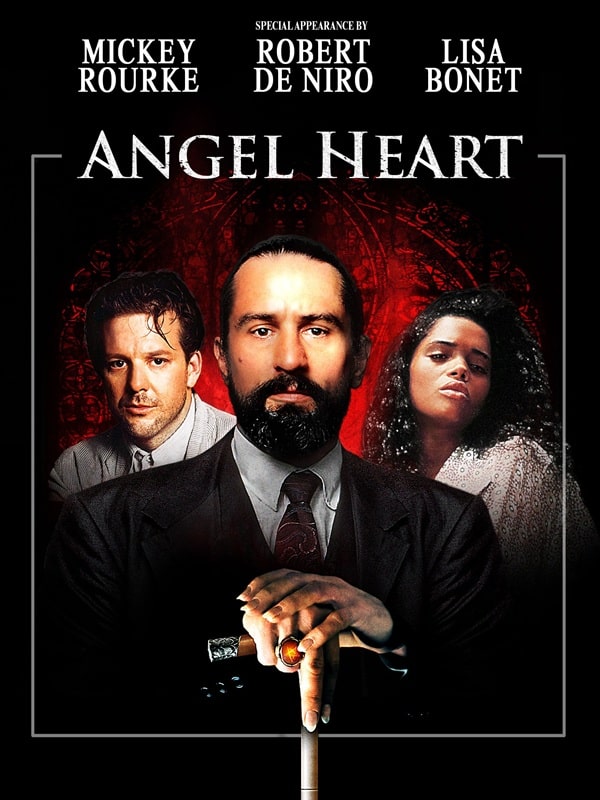 Angel Heart (Tri-Star Pictures, March 6, 1987)
Angel Heart (Tri-Star Pictures, March 6, 1987)
This is how my brain works sometimes.
This week Deadline reported that Robert De Niro will be starring in an upcoming crime drama for Netflix called The Whisper Man based on a novel by the same name. That made me think that when I last saw De Niro, the dude looked pretty old, and that starring in a multi-installment series for Netflix would be pretty taxing. That led me to IMDB to find out how old he really is (De Niro is 81), which resulted in going down the rabbit hole of his incredible career, which led me to Angel Heart (1987).
I had all but forgotten about this film, but the minute I read the name all this controversial stuff about it started resurfacing in my mind. Honestly, I couldn’t recall if Angel Heart was really all that controversial, or if I remembered it wrong and naturally this resulted in a lost afternoon reading everything about it I could get my hands on.
So, here we are and yes, the movie was steeped in controversy.
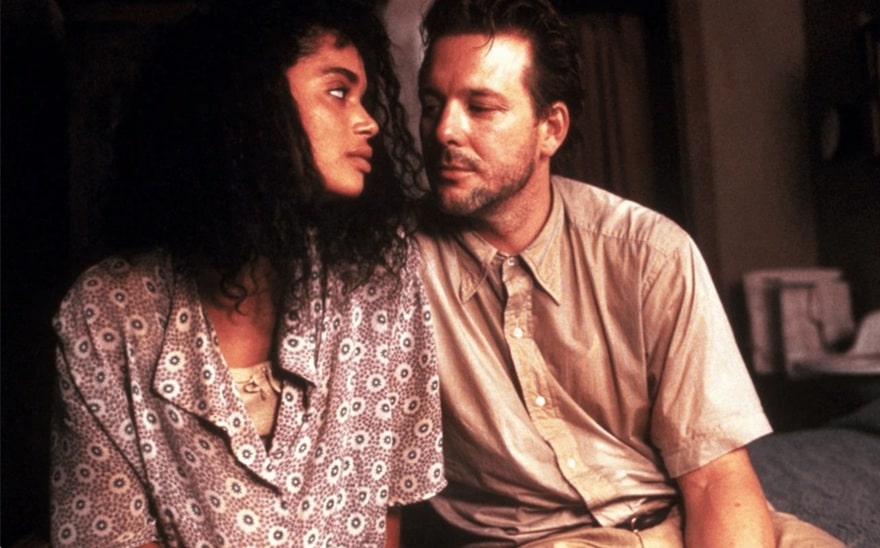 Mickey Rourke and Lisa Bonet in Angel Heart
Mickey Rourke and Lisa Bonet in Angel Heart
Directed by Alan Parker (Midnight Express) and starring the pre-cosmetic surgery hotness that was a young Mickey Rourke, Robert De Niro, and Lisa Bonet (one of those adorable Cosby Show kids), Angel Heart blended the genres of psychological thriller, neo-noir, and horror. Set in 1955 New Orleans, it tells the story of small-time private investigator Harry Angel (Rourke) who is hired by a man who calls himself Louis Cypher (De Niro) to track down a singer named Johnny Favorite.
The investigation takes Angel into the backwaters of the Louisiana bayou where he meets the luscious young Epiphany Proudfoot (Bonet), who also happens to be a voodoo priestess. Suddenly, the trail Angel is following becomes soaked in blood and gruesome murder. So, who is trying to keep Angel from finding his quarry?
To kick off the reasons Angel Heart became a cult classic, after it pretty much bombed at the box office, was that at the time Bonet was best known for her role as Denise Huxtable on The Cosby Show, a wholesome family sitcom. Bonet’s Angel Heart performance included a graphic sex scene and nudity, which led to backlash for her career and to her public image.
Though it didn’t exactly ruin her in Hollywood, Angel Heart made it challenging for Bonet to find roles that matched her previous success. Producers and casting agents often pigeonhole actresses based on public perception, and Bonet’s decision to take on such a provocative role led to her being seen as “too edgy” for mainstream projects (for another example, seee Elizabeth Berkley [Saved by the Bell] and her movie Showgirl [1995]).
While we’re on the topic of sex scenes, the most infamous Angel Heart controversy involved the raw sex scene between Rourke and Bonet. This scene, which featured nudity, blood, and disturbing imagery, pushed boundaries for its time, not the least of which was because of the revelation of an incestuous relationship between Rourke’s and Bonet’s characters. This plot twist, coupled with the explicitness of the scene, sparked outrage and made the film even more polarizing.
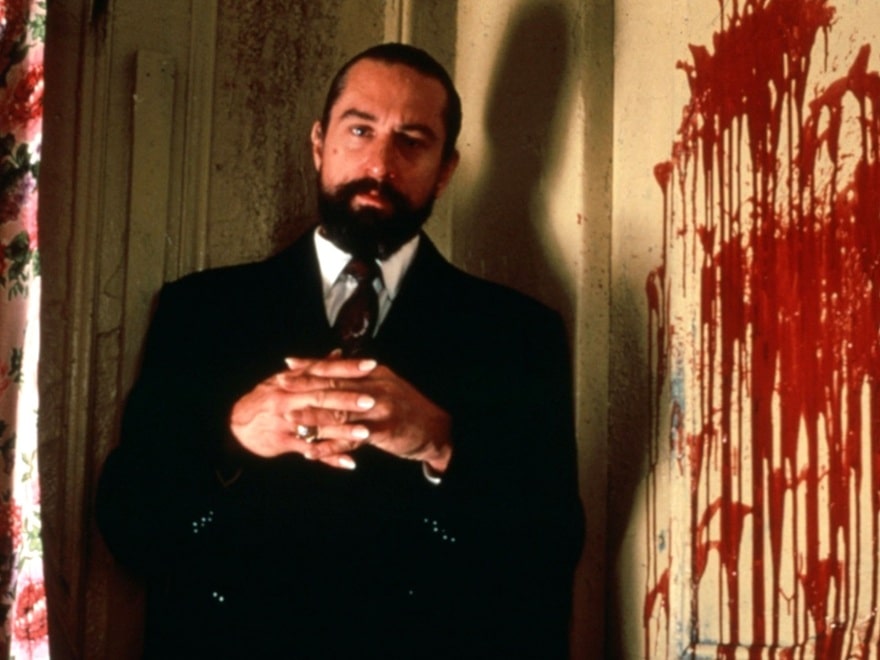 Robert De Niro as Louis Cyphre
Robert De Niro as Louis Cyphre
The film’s depiction of voodoo practices, combined with De Niro’s portrayal of Louis Cyphre (an alias for Lucifer if that hasn’t jumped out at you yet), upset religious groups to no end. De Niro’s performance, though praised by audiences for its eerie subtlety, drew vocal criticism for allegedly glamorizing the devil. Critics accused Angel Heart of promoting occultism and blasphemy, while others argued that the film perpetuated stereotypes about voodoo and Haitian culture, painting them as sinister or evil.
Then there was the violence. Angel Heart is graphically violent, with several brutal and unsettling death scenes, including one involving a character’s heart being ripped out and another being boiled alive in a large vat of jambalaya. The overall dark tones and the depiction of psychological torment left many viewers disturbed, especially as Harry Angel’s true identity and fate are revealed.
The Motion Picture Association of America (MPAA) initially gave the film an X rating. Alan Parker had to cut approximately 10 seconds of footage from Bonet and Rourke’s nude romp to secure an R rating, though many still found the final version shocking. Ironically all the goriest scenes remained intact. You’d never imagine De Niro eating a hard-boiled egg could be so unnerving.
 Mickey Rourke then and now
Mickey Rourke then and now
Yes, I immediately had to give Angel Heart a rewatch – it’s pretty much streaming everywhere. Frankly, I’ve always liked it in the same way I’ve always liked The Ninth Gate (1999) with Johnny Depp. Just suspend your disbelief and go there, provided you can get around the distraction of how the actors have changed (not just aged) in the years since.
Spotlight on Enthralling “Once Was Willem” by M. R. Carey
Mark your calendars, LitStackers! Once Was Willem by M. R. Carey is in presale (the…
The post Spotlight on Enthralling “Once Was Willem” by M. R. Carey appeared first on LitStack.
On McPig's Wishlist - Paladin's Grace
 Paladin's Grace (The Saint of Steel #1)by T. Kingfisher
Paladin's Grace (The Saint of Steel #1)by T. KingfisherStephen's god died on the longest day of the year…
Three years later, Stephen is a broken paladin, living only for the chance to be useful before he dies. But all that changes when he encounters a fugitive named Grace in an alley and witnesses an assassination attempt gone wrong. Now the pair must navigate a web of treachery, beset on all sides by spies and poisoners, while a cryptic killer stalks one step behind…
From the Hugo and Nebula Award winning author of Swordheart and The Twisted Ones comes a saga of murder, magic, and love on the far side of despair.
A Masterful Three Novella Original Anthology: The New Atlantis, edited by Robert Silverberg
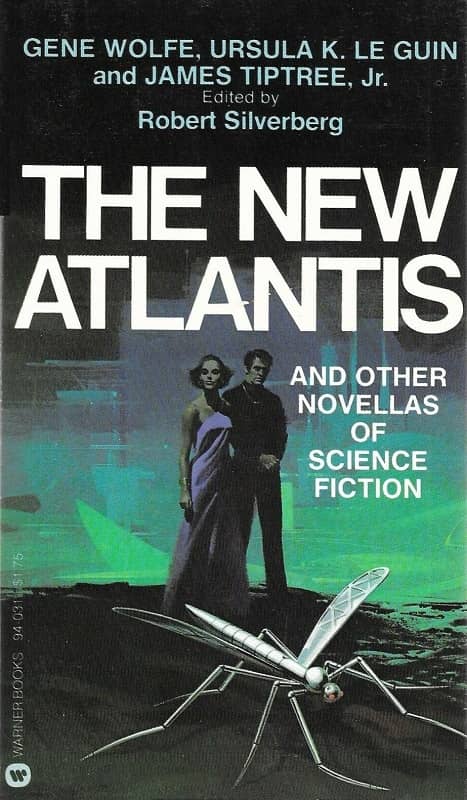
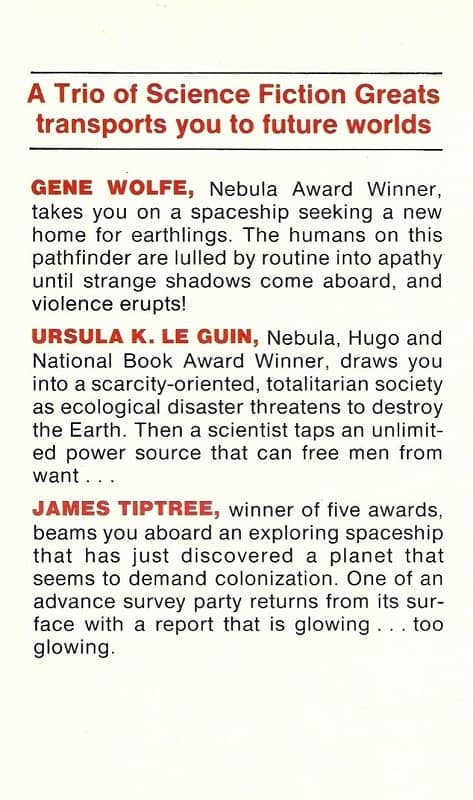
The New Atlantis (Warner Books paperback reprint, 1978). Cover by Lou Feck
My latest look at a book from the 1970s treats a major anthology from 1975. The New Atlantis and Other Novellas collects three long stories: “Silhouette,” by Gene Wolfe; “The New Atlantis,” by Ursula K. Le Guin, and “A Momentary Taste of Being,” by James Tiptree, Jr. The project received plenty of notice at awards time – the book as a whole was fifth in the Locus Poll for Best Anthology, “A Momentary Taste of Being” and “Silhouette” were 7th and 9th, respectively, in the Locus Poll for Best Novella, while “The New Atlantis” won the Locus Poll for Best Novelette, and received a Hugo nomination in that category, and both it and the Tiptree also got Nebula nominations.
Let’s look at the individual stories first.
“Silhouette” by Gene WolfeGene Wolfe was a remarkable writer at all lengths — he produced brilliant short-shorts, short stories, novelettes, novellas, novels, series of novels, even a series of series of novels. “Silhouette,” at about 20,000 words, is one of his novellas — and it may be that the novella was his ideal length.
[Click the images for masterful versions.]
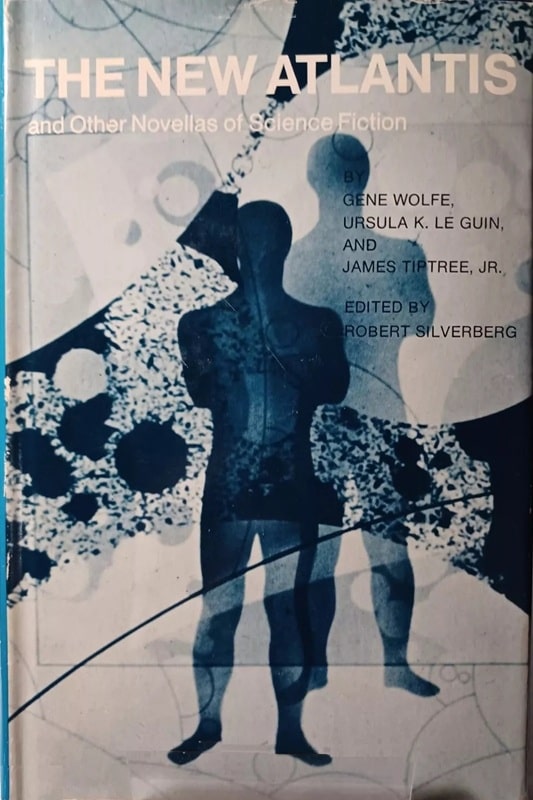 The New Atlantis hardcover edition (Hawthorn Books/Science Fiction Book Club, 1990). Cover by Jorge Hernandez
The New Atlantis hardcover edition (Hawthorn Books/Science Fiction Book Club, 1990). Cover by Jorge Hernandez
At any rate he wrote some 15 novellas, ranging from “The Fifth Head of Cerberus” in 1972, to “Memorare” in 2007; and of these at least “The Fifth Head of Cerberus,” “The Death of Dr. Island,” “Tracking Song,” “The Eyeflash Miracles,” “Seven American Nights,” and “The Ziggurat” rank among the great novellas in SF history. I don’t rank “Silhouette” quite with those stories, but it is a powerful and original piece.
A starship has reached a planet called Neuerrdraht, and the crew are considering whether it is suitable for human habitation. The viewpoint character is Johann, one of the officers, who is skeptical about the prospect of colonization. The ship is deteriorating, however, and the Captain is insistent. There are other factions, including a group that worships the ship’s computer… We get a flavor of life on the ship — a certain grunginess, oppressiveness, with features such as women (except for the Captain) being required to sleep with officers whenever available. Johann has dreams of walking on the surface of the planet, and he is visited by a — shadow? his shadow? something from the planet? A silhouette, at any rate!
The story continues in a disturbing fashion, as the atmosphere on the ship becomes darker. There’s a sense that the ship’s decay mirrors the decay on Earth, from which they had escaped. Johann finds himself confronting the computer-worshippers, and a group that seems intent on mutiny, and people ready to hurt him if he won’t cooperate. With the ambiguous help of the shadow being, he gets through all this, and then comes the actual mutiny, with chaotic and unexpected results.
This is a very good story, but as I said not quite Wolfe at his best. It lacks the truly mysterious aspect that I love most in Wolfe’s work. As I suggest above, I think the best way to read it is to see conditions on the ship as a sort of metaphor — a reflection, even a silhouette — of conditions on the Earth they left. The ship is full of class divisions, and sexual divisions: it’s a particularly oppressive place for women, it seems. And there is no reason to expect colonizing Neuerrdraht will solve anything.
“The New Atlantis” by Ursula K. Le GuinThis is the shortest of these stories, at perhaps 10,000 words. It is set in a ruined near future (to 1975) US, in which climate change has caused sea levels to rise and some parts of the coast are submerged. The country is ruled by a sort of corporatist tyranny, which to my eyes had both right-wing and left-wing elements. The narrator lives in Portland, and her husband has just returned from a prison camp — but they have to be careful, as in this future marriage is illegal. She is a musician, and her husband is a mathematician. And there are rumors of new continents emerging from the ocean.
The narrative alternates passages in the narrator’s POV, with passages from the POV of a mysterious underwater being. The narrator tells of ordinary life in this dismal future: practices her music in the bathroom to frustrate the bug they discovered there, and her husband has friends over, talking dangerously about politics and also about science — in particular, a discovery they have made of a very cheap and portable energy source. The corporatist rulers have a monopoly on energy, and there isn’t enough available to most people. Free energy will be wonderful but destabilizing to the government. . Meanwhile, the sea level keeps rising, and her husband’s risks are clearly threatening their life together. All along the underwater being is telling of what it witnesses, and it’s more or less clear that this is an entity on the rising continent.
The conclusion is mournful, ultimately. There is a sense — ambiguous perhaps — that humanity has irretrievably messed up the planet, and that the “New Atlantis,” which might have been a new sanctuary perhaps? 0r might represent a purified world? — will either be empty or available for humanity’s successors. (But really that’s my speculation purely.)
It’s obvious that aspects of this story seem prescient now, though the story certainly isn’t (and wasn’t trying to be) an accurate prediction of our times. It’s more of an impressionistic, and somewhat despairing, depiction of a decay Le Guin foresaw. And it’s beautifully written.
“A Momentary Taste of Being” by James Tiptree, Jr.This story is by far the longest story here, at some 37,000 words, occupying well over half the book. The setup is curiously similar to that of Wolfe’s “Silhouette”: a starship, the Centaur, has come from a ravaged Earth hoping to find a suitable planet to colonize. As the ship’s name suggests, the solar system being investigated is Alpha Centauri, and as the action opens, Dr. Lory Kaye is in quarantine, having just returned from an expedition to a promising planet. She returned alone, leaving the fellow members of the expedition on the planet, which seems to be a wonderful place, in her telling. She has also brought back a sample of alien life, a large plant-like being. Her ship, and she herself, are quarantined. The story is told from the POV of her brother, Dr. Aaron Kaye, the chief medical officer.
Lory’s tale is received suspiciously by some of the officers. There is minimal actual data retrieved from the planet. There are some hints of what seems to have been violence, or at least disagreements between the various planetary explorers. And there seem to be strange effects on everyone who gets anywhere near the alien plant. But everyone is exhausted by their long mission (10 years) and there is a sense that this is the last chance for the people of Earth. Aaron himself is one of the more skeptical about the planet’s prospects, as is their alcoholic captain. But others desperately want to immediately colonize the planet and send a signal to Earth for others to follow. One man tells Aaron of his plans to set himself up as a sort of petty ruler, complete with an harem (that would include Aaron’s lover Solange.) Aaron, too, is torn by his loyalty to his sister, with whom he had an extended incestuous relationship through their teens.
The story is a rather a slow burn — with a very extended telling of the final day or so of Lory’s quarantine, and of the plans to study the alien plant she brought back; as well as some flashback to Aaron and Lory’s past, and depictions of Aaron’s interactions with other crew members, including a horribly injured man named Tighe, as well as Captain Yellaston, whose alcohol is supplied by Aaron; and the various other officers with their motivations, and descriptions of the somewhat unstable mental state of just about everyone.
But it all culminates in a really powerful final scene, as the nature of the alien plant creature is revealed, and Tiptree’s metaphor for what is really going on becomes clear. It’s a very Tiptree-like ending, and, like so many of her stories, it’s fundamentally about sex and death. Part of me wishes it was somewhat shorter, but perhaps the drawn out beginning is necessary to set up the conclusion. It’s not Tiptree’s greatest story, but it’s one of her most characteristic, I think, and it’s really despairingly effective. Tiptree’s vision, it seems to me, never exactly sunny, became darker and darker throughout the ’70s, culminating in 1980 with “Slow Music,” often called her last great story.
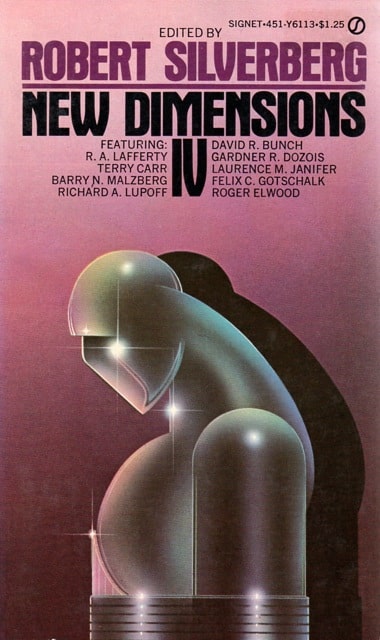
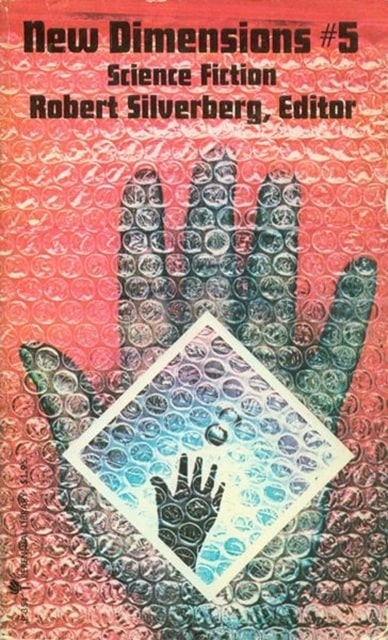
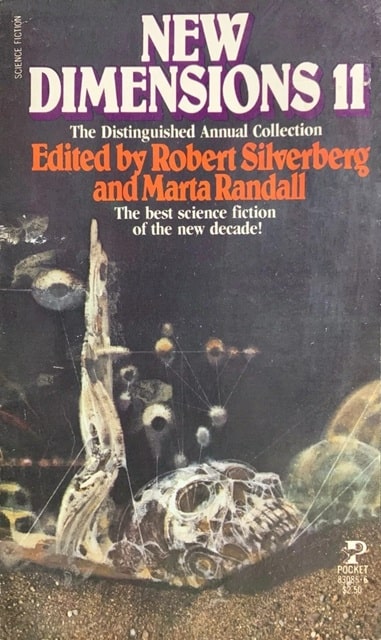
Three volumes of Robert Silverberg’s New Dimensions: IV (Signet, October 1974),
5 (Perennial Library, September 1976), and 11 (edited with Marta Randall,
Pocket Books, July 1980). Cover art: unknown, Joe Harris, Richard Powers
This anthology highlights an aspect of Silverberg’s career for which he perhaps hasn’t gotten the credit he deserves: his influence on SF as an editor and anthologist. And it is possible that the single best original anthology Robert Silverberg produced was this one — The New Atlantis. The three stories are by three of the greatest SF writers of all time, each at the absolute height of their powers. (And, as Silverberg notes in his introduction, all three of these writers came to SF fairly late.)
Silverberg’s editorial contributions go well beyond this book. His original anthology series New Dimensions is remarkable as well, featuring a great many of the best stories of its time. The massive original anthology Epoch (co-edited by Roger Elwood) was far better than its Elwood-stained reputation suggests. He produced many more original anthologies (see sidebar below).
He was also a prolific anthologist of older stories, most notably The Science Fiction Hall of Fame, Volume I, and a wonderful set of 7 books called Alpha. He published quite a few more short anthologies of older SF, and some later doorstops, both original (as with the Legends books, and Far Horizons, plus three books following on the late Terry Carr’s Universe series that he co-edited with his wife Karen Haber), and also reprint books, particularly two Arbor House collections of Great Short Stories and Great Short Novels.
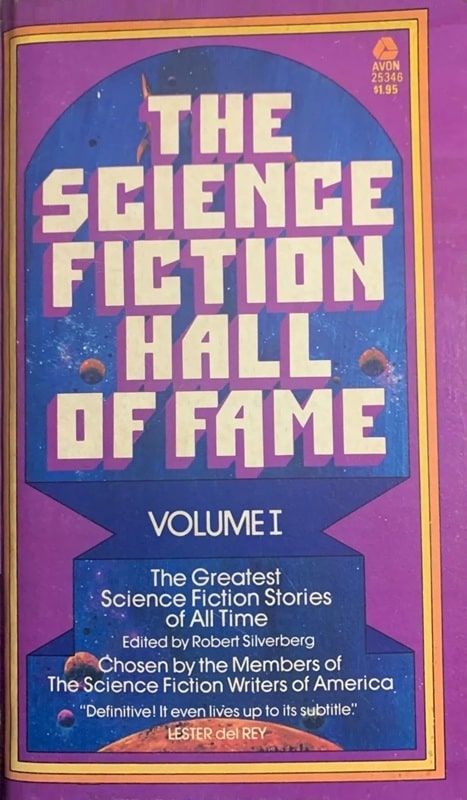
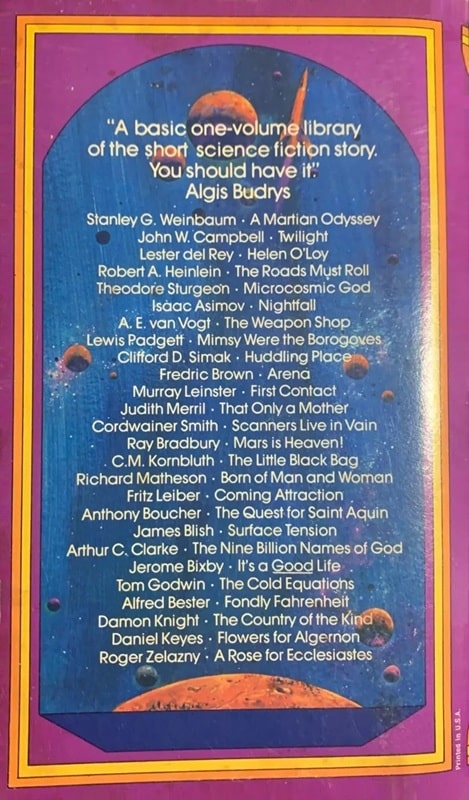
The Science Fiction Hall of Fame, Volume I, edited by Robert Silverberg (Avon, July 1971).
In the decade from 1969 to 1979, Robert Silverberg edited 11 anthologies of original novellas. (One book had four stories.) At the same time Silverberg was producing his original anthology series New Dimensions, and his reprint series Alpha. And that’s not to mention his own fiction — despite a retirement during this period he published some 15 novels and dozens of short stories.
Relatively few examples in the three novella format come from other editors. Silverberg’s primary rival (as I perceive it), Terry Carr, did just one “three novella” book, though a very good one, An Exaltation of Stars. The super prolific Roger Elwood published three, Futurelove, A World Named Cleopatra (with Poul Anderson), and In the Wake of Man. That last book, which had stories by R. A. Lafferty, and Walter F. Moudy, is one of Elwood’s very best, particularly as it features one of Gene Wolfe’s greatest novellas, “Tracking Song.”
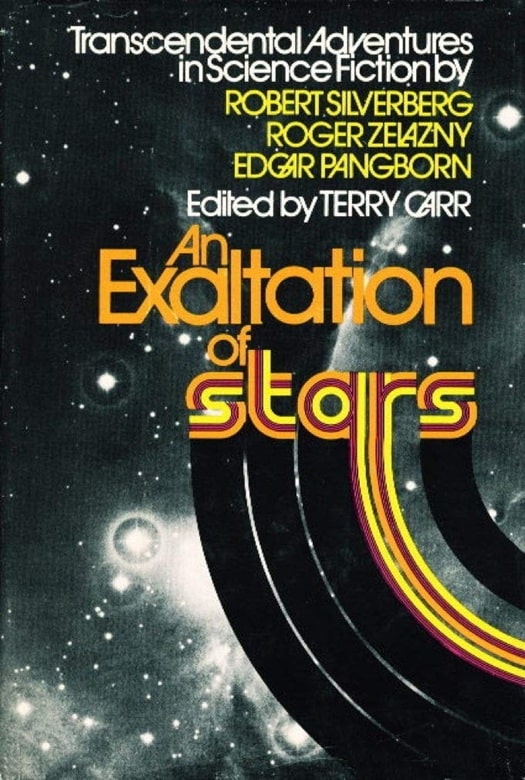
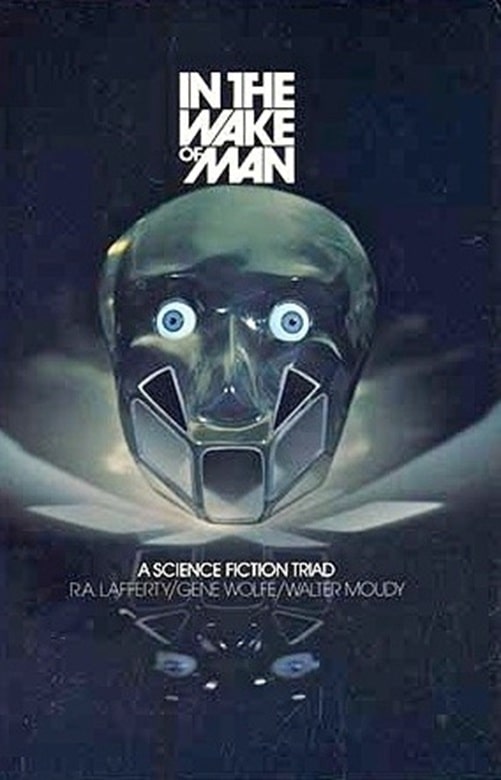
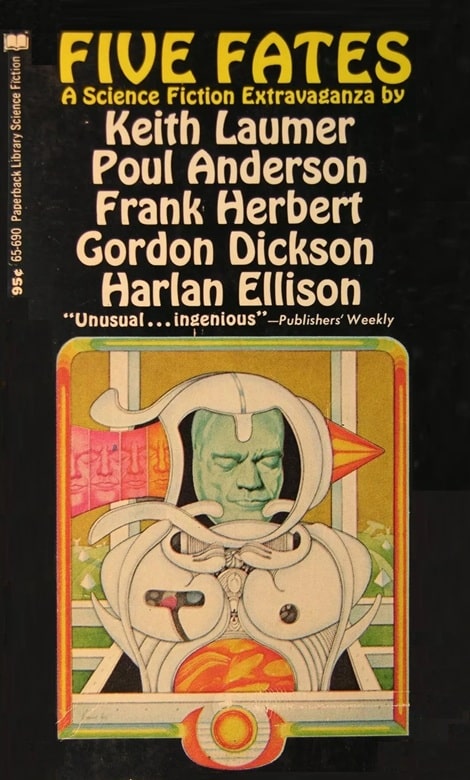
Other anthologies in a novella format: An Exaltation of Stars, edited by Terry Carr (Simon &
Schuster, June 1973), In the Wake of Man, edited by Roger Elwood (Bobbs-Merrill Company,
August 1975), and Five Fates, edited by Keith Laumer (Paperback Library, September 1971).
Cover art by Adelson & Eichinger, Nick Aristovulos, Lorraine Fox
The Anderson collaboration has four stories, all set on the title world, a creation of Anderson’s. (In this sense it mildly resembles the Twayne Triplets of the 1950s, which collected three novellas on the same subject, based on an introductory essay. Several of those books were planned, but in the end only two appeared, Witches Three and The Petrified Planet.) One other anthology of interest is a 1970 book put together by Keith Laumer, Five Fates, in which five writers continued a brief introduction by Laumer, in which a man goes to a Euthanasia center and begins to die — each writer then extrapolates what may happen to this man after (?) death.
Here are the eleven “novella” books Silverberg did.
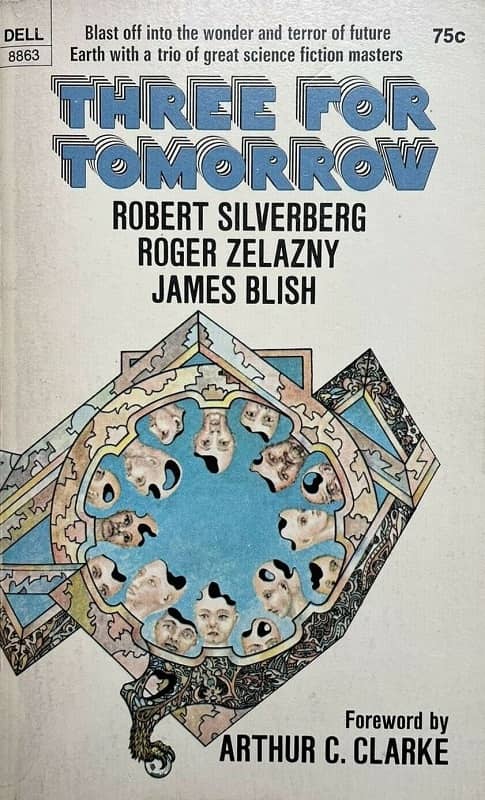
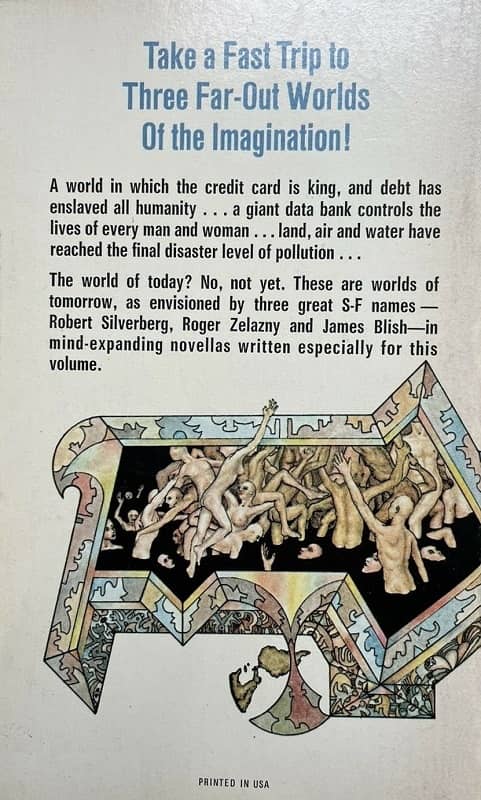
Three for Tomorrow (Dell, 1970). Cover uncredited
How It Was When the Past Went Away • novella by Robert Silverberg
The Eve of RUMOKO • novella by Roger Zelazny
We All Die Naked • novelette by James Blish
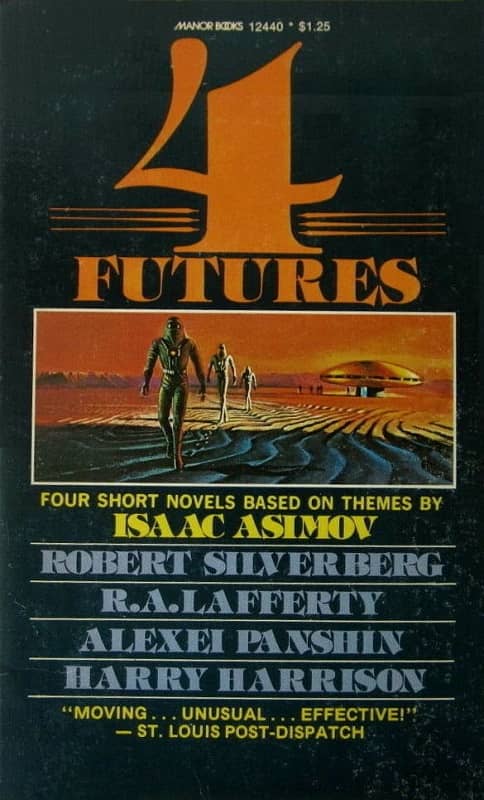

4 Futures (Manor Books, 1976 ). Cover by Bruce Pennington
Ishmael Into the Barrens • novelette by R. A. Lafferty
Brave Newer World • novelette by Harry Harrison
How Can We Sink When We Can Fly? • novelette by Alexei Panshin
Going • novella by Robert Silverberg
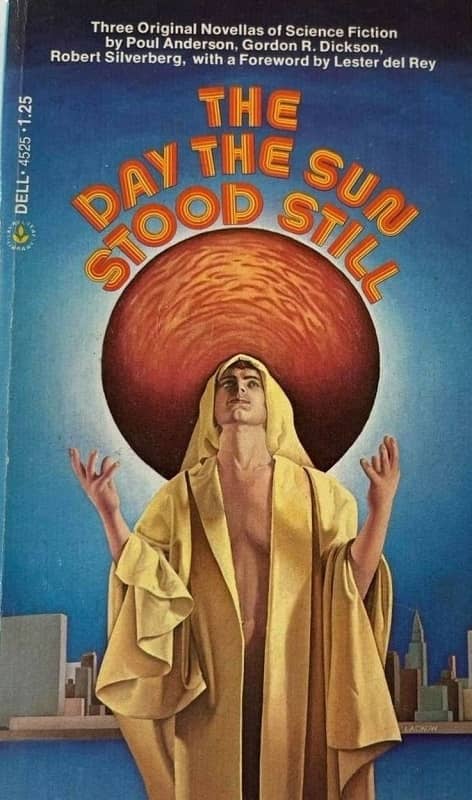
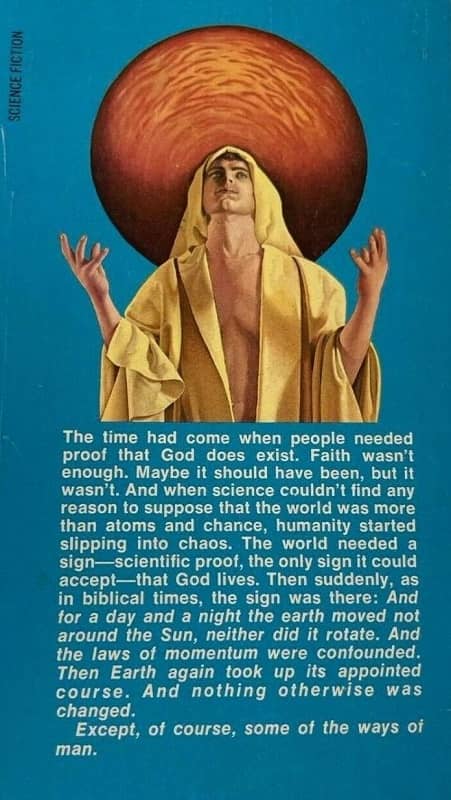
The Day the Sun Stood Still (Dell, 1975). Cover by Andy Lackow
Thomas the Proclaimer • novella by Robert Silverberg
A Chapter of Revelation • novella by Poul Anderson
Things Which Are Caesar’s • novella by Gordon R. Dickson
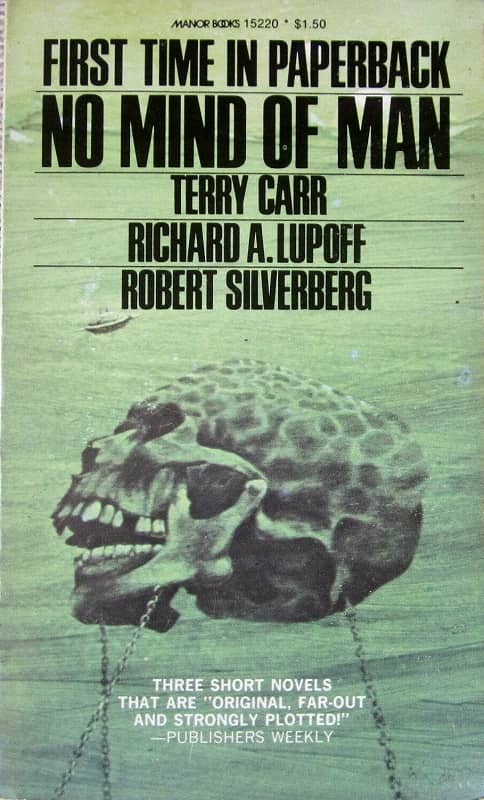
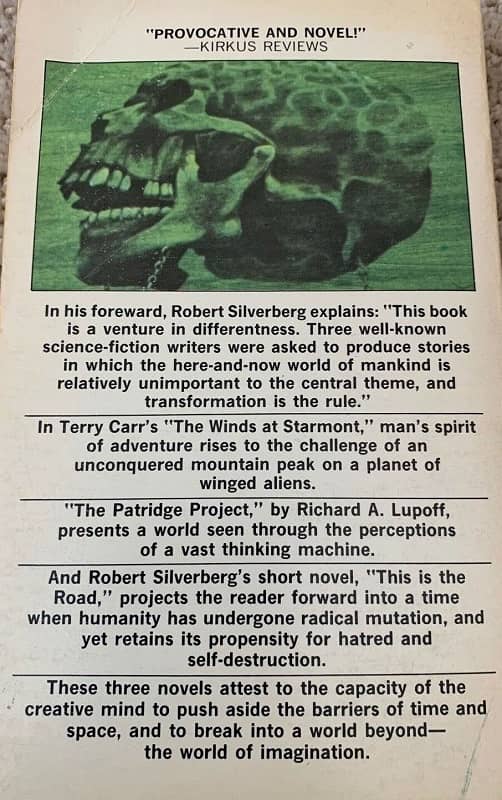
No Mind of Man (Manor Books, 1973). Cover uncredited
The Winds at Starmont • novella by Terry Carr
The Partridge Project • novella by Richard A. Lupoff
This Is the Road • novella by Robert Silverberg
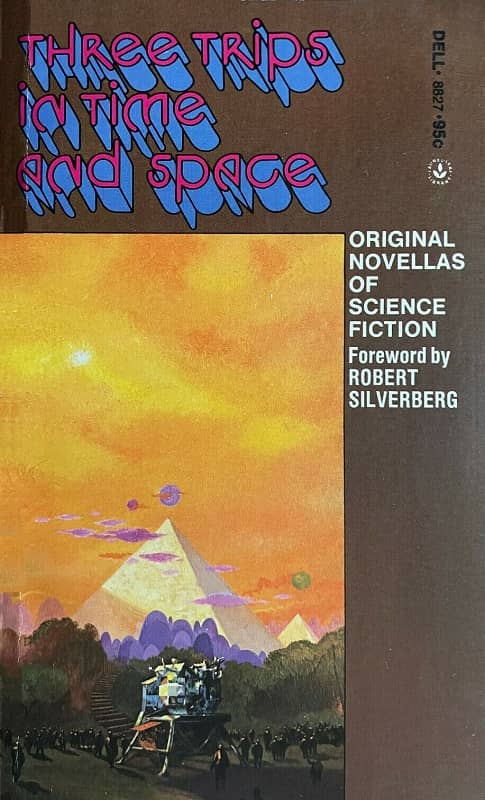
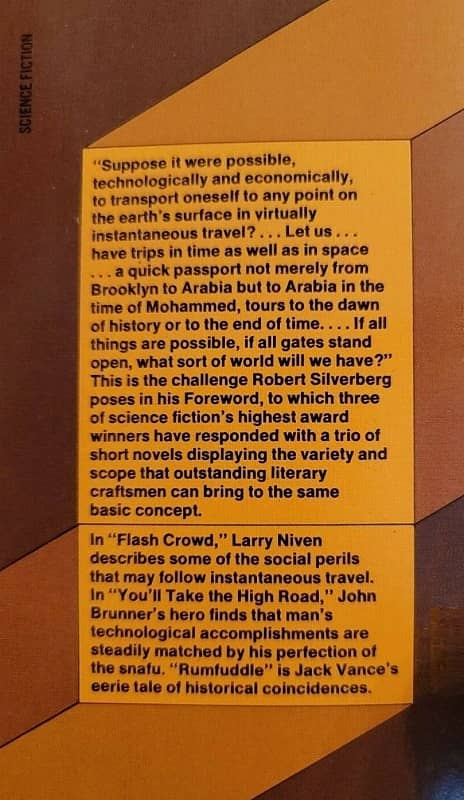
Three Trips in Time and Space (Dell, 1974). Cover by Paul Lehr
Flash Crowd • novella by Larry Niven
You’ll Take the High Road • novella by John Brunner
Rumfuddle • novella by Jack Vance
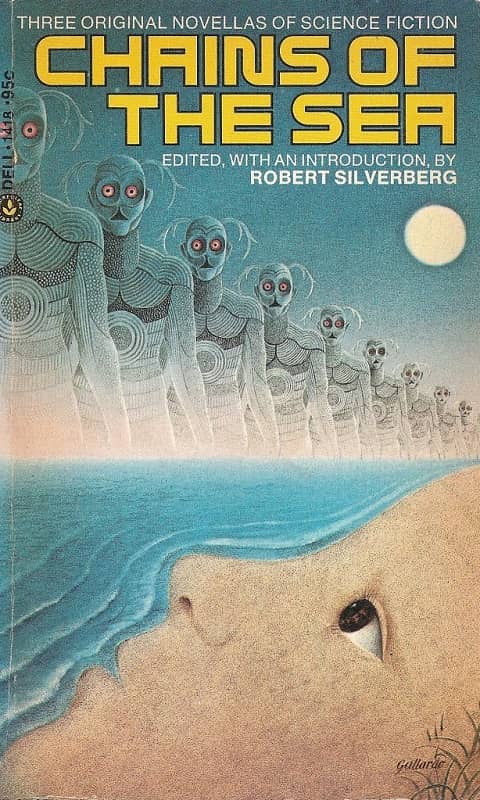
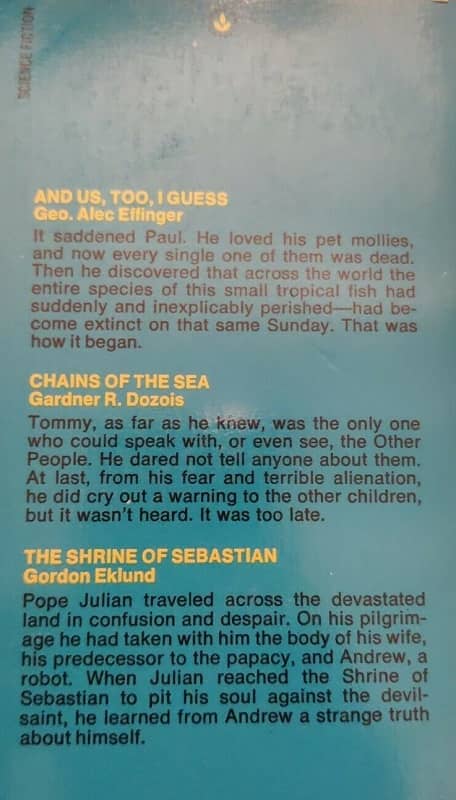
Chains of the Sea (Dell, 1974). Cover by Gervasio Gallardo
And Us, Too, I Guess • novella by George Alec Effinger
Chains of the Sea • novella by Gardner Dozois
The Shrine of Sebastian • novella by Gordon Eklund
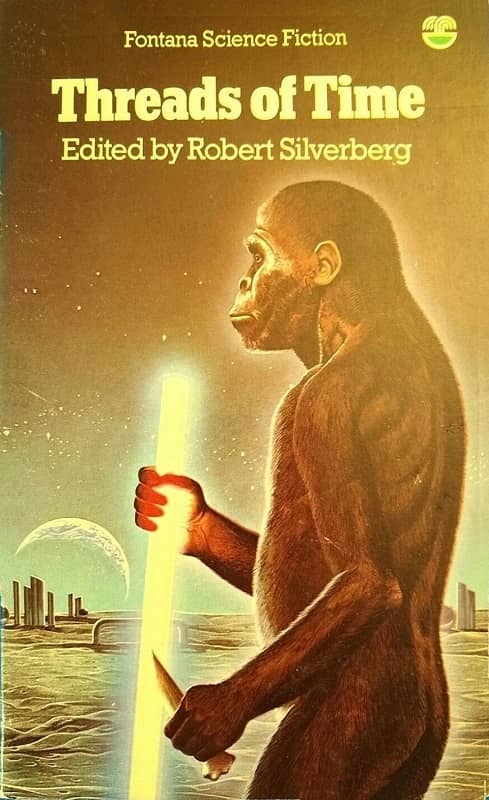
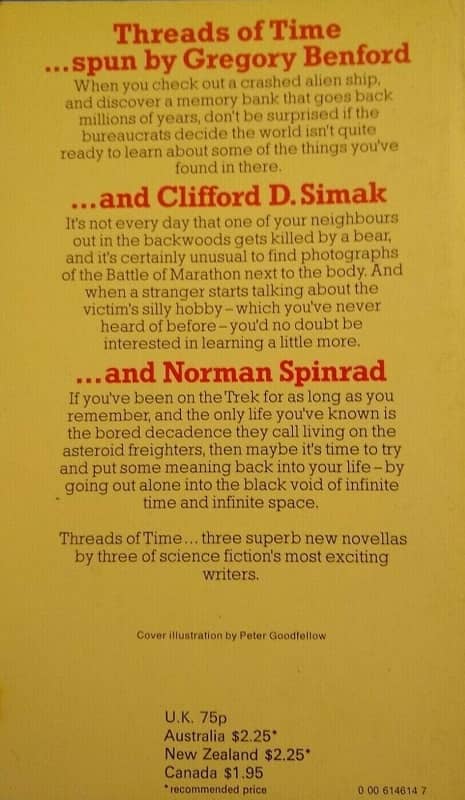
Threads of Time (Fontana, 1977). Cover by Peter Goodfellow
Threads of Time • novella by Gregory Benford
The Marathon Photograph • novella by Clifford D. Simak
Riding the Torch • novella by Norman Spinrad


The New Atlantis (Warner Books, 1978). Cover by Lou Feck
Silhouette • novella by Gene Wolfe
The New Atlantis • novelette by Ursula K. Le Guin
A Momentary Taste of Being • novella by James Tiptree, Jr.
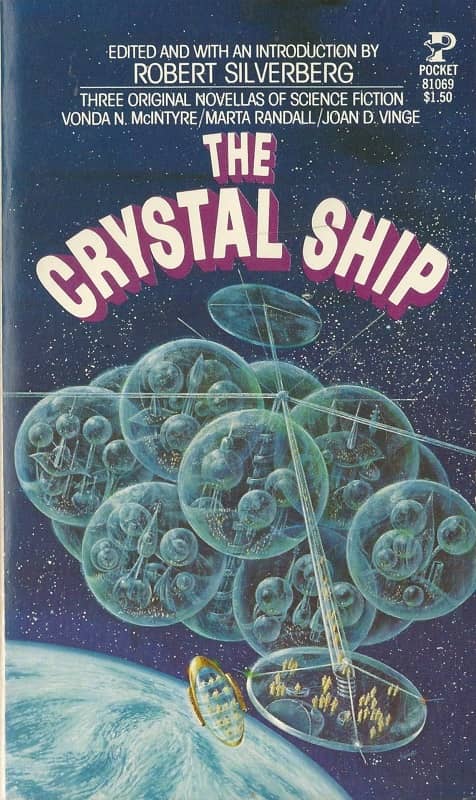
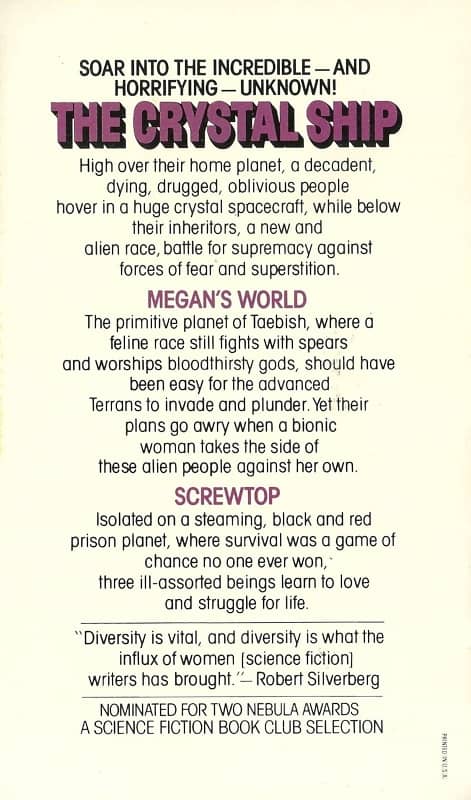
The Crystal Ship (Pocket Books, 1977). Cover byNorman Adams
The Crystal Ship • novella by Joan D. Vinge
Megan’s World • novella by Marta Randall
Screwtop • novella by Vonda N. McIntyre
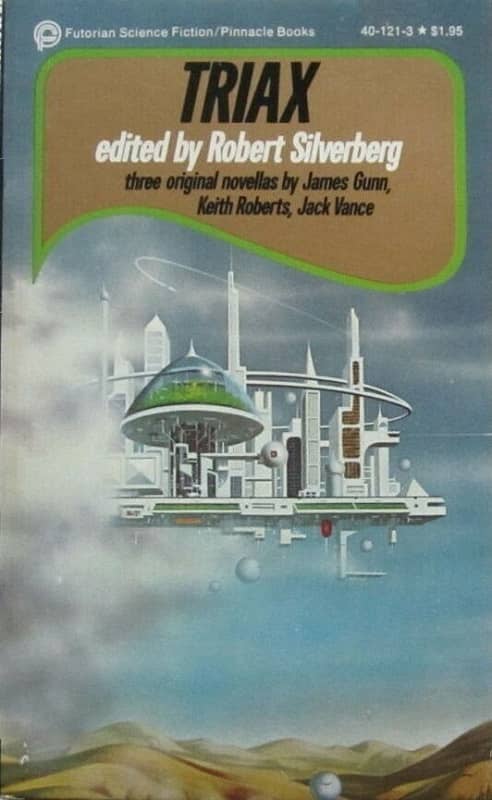
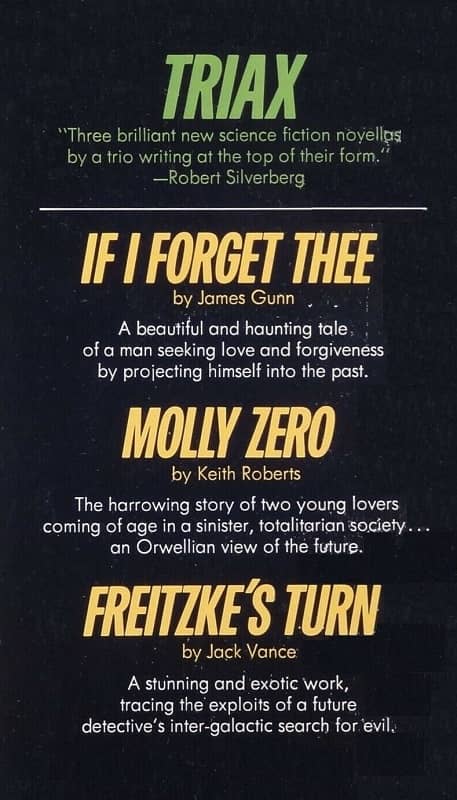
Triax (Pinnacle, 1977). Covers by Randy Weidner
Molly Zero • novella by Keith Roberts
If I Forget Thee • novella by James E. Gunn
Freitzke’s Turn • novella by Jack Vance
The Edge of Space hardcover edition (Elsevier/Nelson Books, 1979). Wraparound cover by Freff
The Edge of Space (1979)The King’s Dogs • novella by Phyllis Gotlieb
In the Blood • novella by Glenn Chang
Acts of Love • novella by Mark J. McGarry
Rich Horton’s last article for us was an obituary for Barry N. Malzberg. His website is Strange at Ecbatan. Rich has written over 200 articles for Black Gate, see them all here.
7 Author Shoutouts | Authors We Love To Recommend
Here are 7 Author Shoutouts for this week. Find your favorite author or discover an…
The post 7 Author Shoutouts | Authors We Love To Recommend appeared first on LitStack.
Party Planning Can Be Murder - Early Book Review
 Party Planning Can Be Murder: A Party Planner Mysteryby Kerry Schafer/Kerry Anne King
Party Planning Can Be Murder: A Party Planner Mysteryby Kerry Schafer/Kerry Anne KingWhat is it about:Wish List: pick up my pills from the pharmacy, plan my party, be there when I die…
Despite a few harrowing incidents with nervy Bridezillas, Addy Winters’ small town party planning business has been murder free – until now. But then, she’s never before been hired to throw a star-studded after-death party for a client who has their death scheduled on their calendar.
When Leno Masterson—former classmate, now legendary rocker with a flair for drama—turns up dead four days earlier than he’d planned, Addy suspects that someone helped him along. Sure, he left a melodramatic goodbye letter and his right-to-die paperwork is all in order, but even when the coroner rules natural causes, Addy isn’t buying it.
Addy’s family and friends – and Leno’s smolderingly hot brother Owen – warn her that she’s diving in over her head, and they’re right. She’s woefully unprepared for either the media onslaught or the secrets the people she thought she knew are hiding. But nothing is going to stop her from getting justice for Leno – and throwing a killer party while she’s at it.
If you love your mysteries with humor, heart, and a side of romance, this is your next must-read. Perfect for fans of Finlay Donovan and The Thursday Murder Club!
What did I think of it:There are some authors you follow to whatever genre they decide to write next. Kerry Schafer is one of those authors. When she switched from Urban Fantasy & Paranormal Thrillers to Women's Fiction as Kerry Anne King, I followed and loved those books as well. Her next release will be by both pen names and is a Murder Mystery!
You bet I jumped on the chance to be an early/ARC reader and let me tell you I devoured this book!
I was drawn in and emotionally invested from the first chapter. I fell in love with Addy and wanted her to succeed in everything she does. (I also thought some very not nice things about her family, apart from her brother and grandmother.)
I was already enjoying myself very much with this story when Leno turns up dead and the mystery begins. And I can tell you: there's tons of things Addy has to figure out to discover what happened to Leno. I couldn't stop reading: I needed to know who or what caused Leno's death.
The writing (as with every book Kerry has written) is so good in my opinion. There's lots of humorous situations and the writing fits those perfectly.
Voodoo Bride wants me to mention Owen: according to her Owen was the dreamiest and coolest character in the book. I myself can't say if he is indeed the dreamiest, but he for sure was a character I really didn't want to see ending up as the killer.
I'm not going to spoil the ending of course, but you can bet I want more books in what I hope will become a long series. I'll also grab the print version to hug and reread once this releases next month.
Why should you read it:It's an awesome Mystery read!
Expected publication: March 11, 2025
Review: Murder by Memory by Olivia Waite
 Buy Murder by Memory
OFFICIAL AUTHOR BIO: Olivia Waite writes queer science fiction, fantasy, historical romance, and essays. She is the romance fiction columnist for the New York Times Book Review.
Buy Murder by Memory
OFFICIAL AUTHOR BIO: Olivia Waite writes queer science fiction, fantasy, historical romance, and essays. She is the romance fiction columnist for the New York Times Book Review.FORMAT/INFO: Murder by Memory will be published by Tordotcom on March 18th, 2025. It is 112 pages long. It is available in ebook, hardcover, and audiobook formats.
OVERVIEW/ANALYSIS: When Dorothy Gentleman, ship's detective, wakes up in a body that isn't hers, she's more than a little annoyed. After all, she's supposed to be retired, her mind resting in the ship's Library until she decides to print a body again. And even if she'd chosen to wake up, she should be in a fresh body all her own. But there's been a murder on the ship, and what's worse, someone is deleting the memory archives from the Library itself - something that should be impossible.
Murder by Memory is a fluffy fun little appetizer that left me longing for a deeper dive into this world. The mystery itself is pretty straight forward. Dorothy goes from point A to B to C in fairly quick succession, following the clues on a mostly linear path. It's not going to scatter red herrings on your trail or give you a cast of suspects to consider. In fact, the mystery is less about the Who than it is about the Why and the How.
Instead, I was much more intrigued with puzzling out the ship the murder takes place on. The H.M.S. Fairweather is on a thousand year journey to a new planet. But with the technology to back up a person's mind, it's not a traditional generation ship; there isn't a constant turnover of populace because a person can simply print themselves into a fresh body when their old body gives out. This opens up a whole host of fascinating societal questions that Murder by Memory only barely begins to touch on, but it was enough of a glimpse that I wanted to know more.
I was also impressed by the way the author quickly sketched out her core cast of characters, from Dorothy herself to Ralphie her well-meaning but not always sensible nephew to his mysterious bartender boyfriend. They don't have deep backstories given the length of the novella, but I got enough of a sense of them that I wanted to spend more time with them, as much as I wanted to explore the ship.
CONCLUSION: Murder by Memory is like an episode of a weekly crime procedural. You'll know most of the beats, but you'll enjoy it anyway for the comfort of the familiar, and you'll want to return the cozy cast of characters. As this is the start of a new sci-fi mystery series, I'm definitely looking forward to more adventures in this world, but I do find myself wishing this were a main course instead of a snack.
What a Croc, Part II
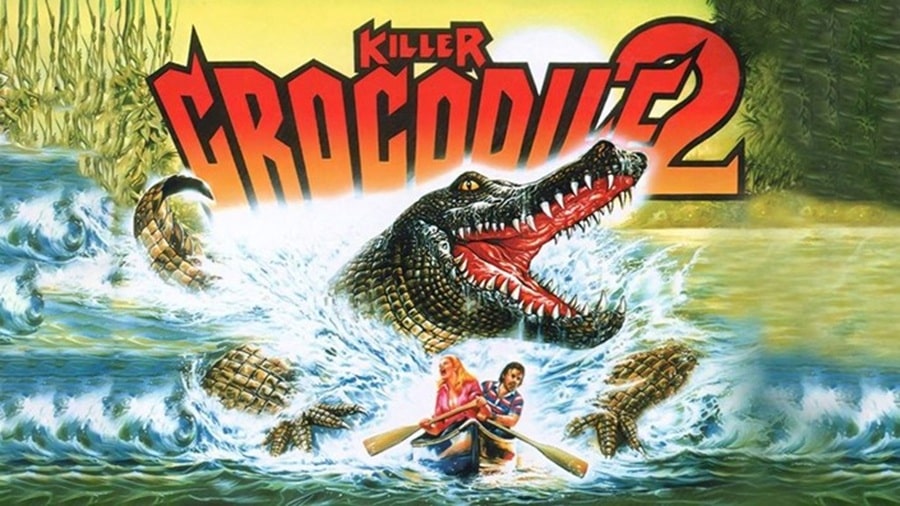 Killer Crocodile 2 (Fulvia Film, 1990)
Killer Crocodile 2 (Fulvia Film, 1990)
My next watch-a-thon is a favourite genre: crocs and gators. Unfortunately, this means the pickings are a bit slim, as I’ve already seen most of them, but I’ve managed to dig up 15 so far (supplemented with a Gila Monster and a couple of Komodos), and I’m sure the intended list of 20 will materialize as streaming services start suggesting titles.
Killer Crocodile 2 (1990) TubiCroc or gator? Crocodile. Again.
Real or faker? A hilarious puppet. The same one.
Any good? A direct follow on from the first story, this time the offspring of the first puppet is doing the chewing. Nefarious types are still dumping toxic waste, thrill seekers are still inexplicably wakeboarding in the world’s muddiest river, and ladies are still getting their kit off for a leaden leading man. Actually, the sexy pillow talk is a highlight. “Don’t you know that fear and near death situations stimulate and heighten a man’s reproductive organs?” Phwoar, steady on, love, you had me at ‘Don’t’.
[Click the images for gator-sized versions.]
The first film featured an unsettling attack on a small boy, but this one ups the ante by having a whole canoe-load of kids get eaten while a nun prays for salvation. Glorious hokum.
6/10
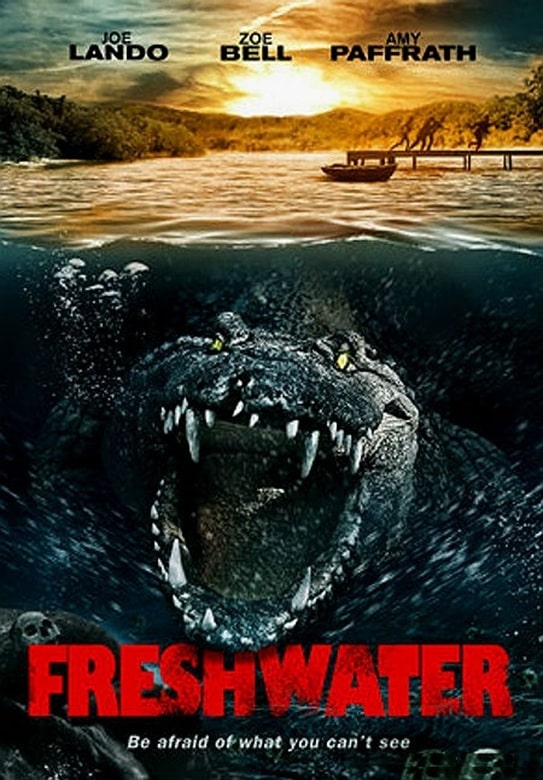
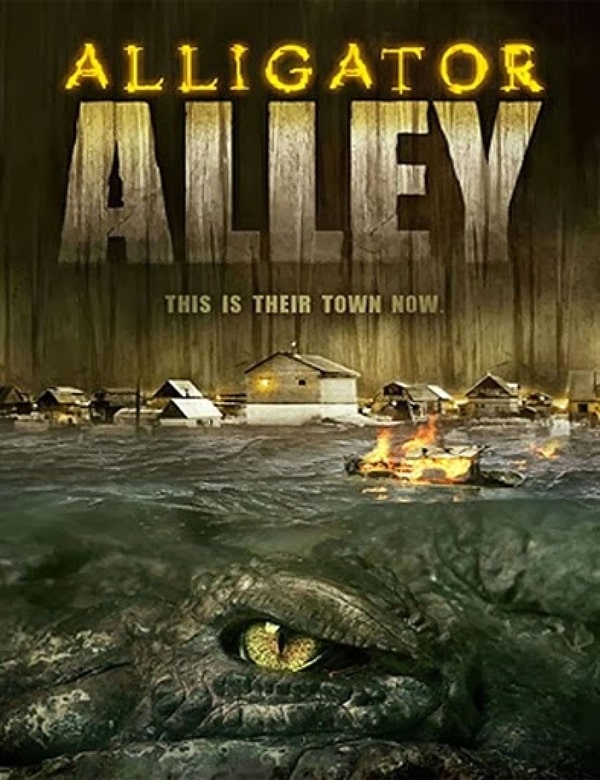
Freshwater (MultiVisionnaire, February 26, 2016) and Alligator Alley (Active Entertainment, 2013)
Croc or gator? Gator, possibly.
Real or faker? Let’s just say, when we do see a gator, it’s rubbish.
Any good? I’m torn, and not in a good way. There’s an awful lot wrong with this one, the script, the directing, the editing, the score (dear God, that score), most of the acting, the effects, and yet it tries something different (no spoilers, but it’s not what I was expecting) and I applaud the ballsy ending.
However, when the intended humor falls flat but your audience laughs at everything else, that ain’t good. Makes for a good drinking game if you are counting poor decisions (the first being to watch this optimistically).
5/10
Alligator Alley (2013) YouTubeCroc or gator? Gators!
Real or faker? Reasonably dodgy CG.
Any good? Also known as Ragin Cajun Redneck Gators, you know exactly what to expect going into this SyFy slice of grilled ham, and yet it upends those expectations with a hearty fart in the face. Toxic moonshine mutates gators into dart firing rascals whose bites turn folks into more gators (I kid you not). It’s all set against the backdrop of a family feud down south, and is as ludicrous as you might imagine.
It’s rubbish, but it’s daft rubbish, which is about as good as it gets these days, so I’m not hating it.
6/10
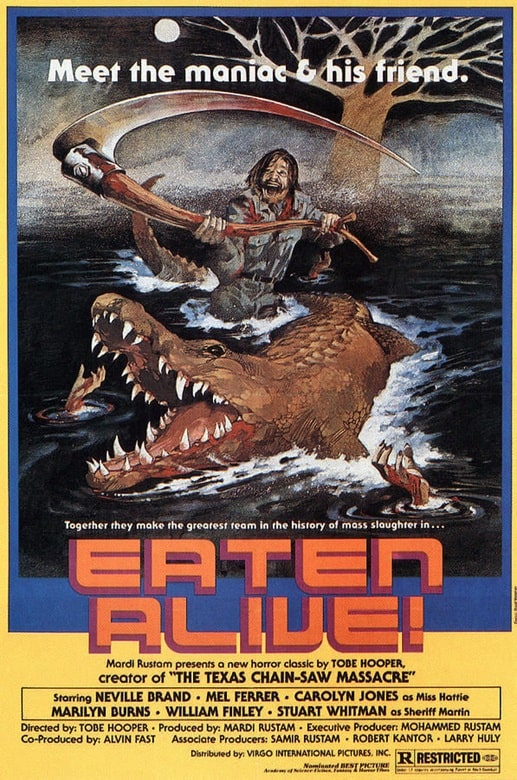
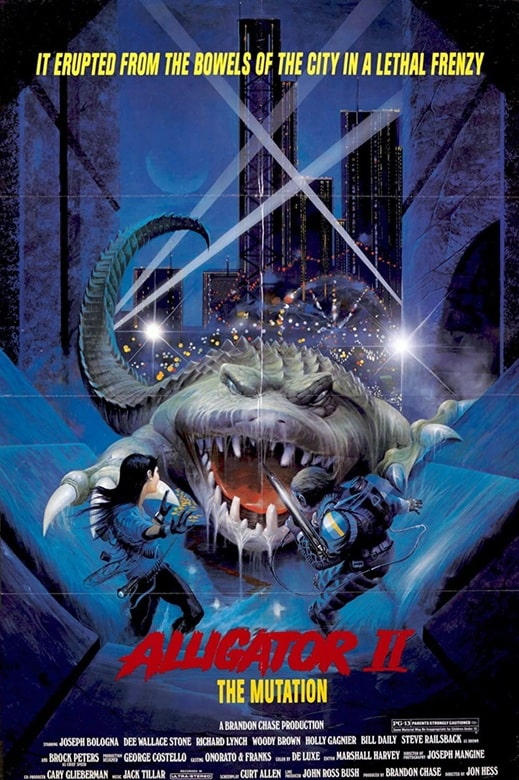
Eaten Alive (Mars Productions, October 18, 1976) and Alligator II: The Mutation (New Line Cinema, June 5, 1991)
Croc or gator? Nile Croc!
Real or faker? Cute papier mache monster.
Any good? Some good has come out of this ill-considered project, for I have finally watched the missing Tobe Hooper film in my life — a film banned in the UK until 1998 as part of Mary Whitehouse’s Video Nasty apocalypse. Though tame by today’s standards, the film does come with a warning for modern audiences as besides a bit of gore, it contains racial slurs and attempted rape.
This is Robert Englund’s first film role, and his big screen intro is “My name’s Buck, and I’m here to fuck.” Funny to think that he was roomies with Mark Hamill at the time, who was busy on his own little film.
The entire film is shot on a soundstage, and although the grimy motel is impressive enough, the exterior shots have an unearthly quality to them, surreal, dreamlike, bathed in red neon and resembling the last days. It’s atmospheric as all heck, with killer sound design, but it might be an uncomfortable watch for some (women are only present to get undressed). Neville Brand as the Norman Bates-ish ‘Judd’ is excellent, and the croc itself gets to do some fun chomping.
8/10
Alligator 2: The Mutation (1991) YouTubeCroc or gator? Alligator.
Real or faker? Stock footage and a rubbish puppet.
Any good? 11 years after the excellent and enjoyable first movie, someone decided to remake it, but make it boring. This film is missing two key ingredients, Robert Forster and a decent alligator.
Richard Lynch, Steve Railsback and Dee Wallace are welcome additions, but even they can’t save this dull ordeal. The story is the same as the first — a sewer alligator grows big and mean due to toxic waste, a corrupt businessman throws a party, rinse, repeat. However, where the first film kept its tongue in its cheek and actually showed us a big ol’ alligator, this one relegates its rubbish effects to the dark of the sewers, ensuring we see nothing for most of the film. Dull.
4/10
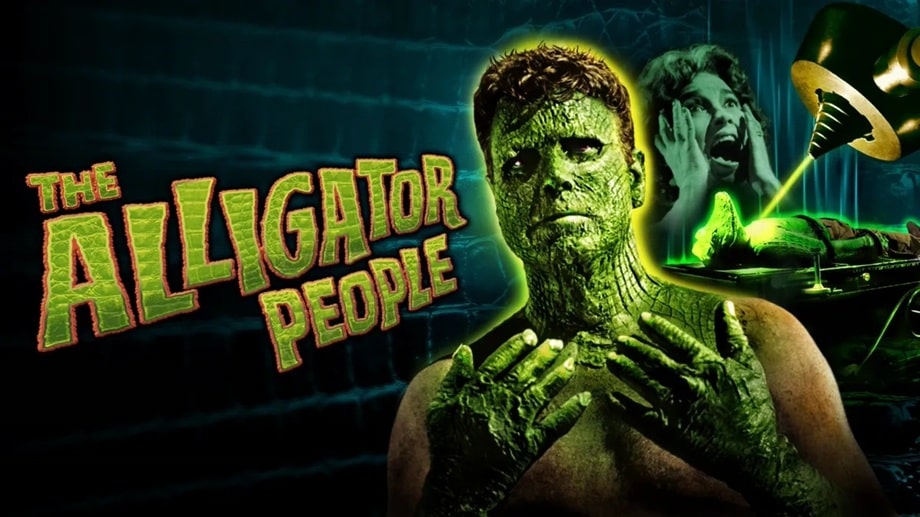 The Alligator People (20th Century Fox, July 22, 1959)
The Alligator People (1959) Disney+
The Alligator People (20th Century Fox, July 22, 1959)
The Alligator People (1959) Disney+
Croc or gator? Alligator people!
Real or faker? Real gators and some great makeup.
Any good? One of those classics that somehow passed me by — I suspect the hokey still used in every book didn’t inspire much confidence in me — but I was horribly mistaken. Far from being the B-movie cheesefest I was expecting, it was surprisingly compelling, with a decent plot, lovely writing (the narration is poetic) and makeup by none other than Ben Nye and Dick Smith!
Lon Chaney is creepy as all heck, Beverly Garland is lovely, and the whole affair drips atmosphere and dangly moss. There’s a bit of abuse aimed at some (real) gators, so animal lovers beware, but I ended up both enthralled and charmed and I’m very happy to finally tuck this one away.
8/10
Previous Murkey Movie surveys from Neil Baker include:
What a Croc, Part I
Prehistrionics
Jumping the Shark
Alien Overlords
Biggus Footus
I Like Big Bugs and I Cannot Lie
The Weird, Weird West
Warrior Women Watch-a-thon
Neil Baker’s last article for us was What a Croc, Part I. Neil spends his days watching dodgy movies, most of them terrible, in the hope that you might be inspired to watch them too. He is often asked why he doesn’t watch ‘proper’ films, and he honestly doesn’t have a good answer. He is an author, illustrator, outdoor educator and owner of April Moon Books (AprilMoonBooks.com).
Teaser Tuesdays - The Spellshop
 Kiela never thought the flames would reach the library. She was dimly aware that most of the other librarians had fled weeks ago, when the revolutionaries took the palace and defenestrated the emperor in a rather dramatic display.
Kiela never thought the flames would reach the library. She was dimly aware that most of the other librarians had fled weeks ago, when the revolutionaries took the palace and defenestrated the emperor in a rather dramatic display.(page 1, The Spellshop by Sarah Beth Durst)
---------
Teaser Tuesdays is a weekly bookish meme, previously hosted by MizB of Should Be Reading. Anyone can play along! Just do the following: - Grab your current read - Open to a random page - Share two (2) “teaser” sentences from somewhere on that page BE CAREFUL NOT TO INCLUDE SPOILERS! (make sure that what you share doesn’t give too much away! You don’t want to ruin the book for others!) - Share the title & author, too, so that other TT participants can add the book to their TBR Lists if they like your teasers!
A HOUSE with GOOD BONES by T. Kingfisher
Monday Musings: Here We Are

 We woke this morning to a snow squall, something that happened with ever-decreasing frequency during our years in Tennessee, as climate change made the warm South even warmer. Here in New York, during the winter months, snow is still the default when there’s precipitation, and I love that. I have missed snow and don’t mind paying the plow guy or dealing with snow on the walkways and driveway. The beauty of an early morning snowfall more than makes up for the inconveniences.
We woke this morning to a snow squall, something that happened with ever-decreasing frequency during our years in Tennessee, as climate change made the warm South even warmer. Here in New York, during the winter months, snow is still the default when there’s precipitation, and I love that. I have missed snow and don’t mind paying the plow guy or dealing with snow on the walkways and driveway. The beauty of an early morning snowfall more than makes up for the inconveniences.
We have bird feeders up now, and they’ve drawn in a variety of species, including several species of sparrow, goldfinches and cardinals, chickadees and nuthatches and woodpeckers. They have also drawn the attention of local hawks, who seem to view our feeders as an all-they-can-eat avian buffet. We have a Cooper’s Hawk who frequents the yard, a pair of Red-tails who come around quite often, and, as of yesterday, a gorgeous Red-shouldered Hawk. Our turkey flock continues to wander through the yard now and then, as does a beautiful red fox. A couple of weeks ago, while driving past the farm that borders our property on the western edge, I spotted a young Peregrine Falcon perched on a telephone pole, hungrily eyeing a flock of doves.
I haven’t written in this blog for a few weeks, and in a way what you’ve just read is why. I am working again, we have settled into a routine of sorts. The house still needs a good deal of work, and we’re getting around to that slowly, steadily. We are enjoying this setting immensely. We’re eating fun foods and finding new stuff to stream. We’re spending lots of time with my brother and his family, who live close by, and lots of time with my college roommate and musical partner and his wife, who also live maybe 20 minutes from here.
Life is comfortable and peaceful and, I will also admit, a tiny bit boring. Not to me, mind you, but I can definitely see where it could seem that way to those on the outside. We traveled a lot last year. This year we’re planning to (mostly) stay put and work on our new place. The past several years have been full and fraught, difficult beyond words at times, and at other times so frantic as to be exhausting. This year won’t be like that. Not if we can help it.
And so, yeah, I have struggled to post. I don’t want to bore. I don’t want to repeat material from old posts.
I continue to grieve for my older daughter. I’ll never stop. But I feel I have made that grief part of my life, part of who I am now, and honestly, I wouldn’t have it any other way. I don’t feel the same need to write about it that I felt last year. And I think many grew tired of such posts. Grief is part of me, but it does not — should not — define me.
I don’t really want to think about the slow-motion disaster unfolding in our nation’s capital. This administration’s attempts to subvert the Constitution and undo a century of progress on Civil Rights, environmental protection, social justice, and a host of other worthy goals is not something upon which I care to dwell. I am too weary to engage in online flame wars with troglodytes and nazis. At some point, I’ll grow angry enough to write a political screed or three, but not now.
And at some point, I am sure, I will have much to say about new writing projects. For now, though, I’m merely editing, and enjoying quiet, productive days in my new work space.
All of this feels healthy, and deeply appropriate for this current stage of my life. None of it makes for exciting reading (or writing). I will do my best to post as I can, to come up with things to say that make something worth reading out of our mundane-albeit-cozy existence. But to those who know us and care about us, please be assured that we are doing well. Better than we would have thought possible a little over a year ago. Some days are harder than others. But we are where we ought to be, physically and emotionally. It’s hard to ask for more.
Wishing all of you a wonderful week.
Spotlight on “Flux” by Jinwoo Chong
Flux is a New York Times Editor’s Choice, Best Book of 2023 by Esquire, Apple…
The post Spotlight on “Flux” by Jinwoo Chong appeared first on LitStack.
Looking Back at RTS – and Myth: The Fallen Lords
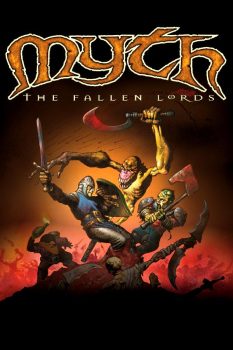 So….one of the rabbit holes I periodically jump down is Total War: Warhammer II. That’s easily my favorite in the Total War series (I played a boatload of TW: I as well. You can use units from I, in II, in some campaigns, which increases the utility of the first game. I appreciate that.
So….one of the rabbit holes I periodically jump down is Total War: Warhammer II. That’s easily my favorite in the Total War series (I played a boatload of TW: I as well. You can use units from I, in II, in some campaigns, which increases the utility of the first game. I appreciate that.
I struggle with the first 15-or-so turns, and frequently abandon a new game, pick another faction, and try again. I like playing different factions, so that’s fine. Also, I often plateau around 70-75 turns, and start a new game as well.
I reinstalled TW: I and II last month and have been playing again. It’s been fun. After a half-dozen false starts, I’m having one of my most successful games leading a chivalry-based, Middle Ages-type faction (WH is a fantasy world, with elves, orcs, beastmen, etc). And I realized I was applying the principles that George Washington advised America about in his famous Farewell Address. Being a Constitutional Convention of 1787 wonk, I’m reasonably familiar with Washington, who presided over the Convention.
However, as I type this right now, it is obvious that such a post is definitely not gonna be ready for tomorrow morning (which would be when this one went live – Monday the 3rd.
And let met tell you, there are multiple elements of Washington’s Address that apply today. Including about people in the country undermining it by pitting one group against another. And that applies to quite a few groups/people…
So instead, we’re talking about a few Real Time Strategy (RTS) games I’ve played over the years. The basic definition of RTS is games that don’t move forward incrementally in turns, but move along in ‘real time.’
The old Warcraft: Orcs and Humans was the first one I really got into, way back in the mid-nineties, which was the birth era of RTS. I never played World of Warcraft, but I ate up the first two Warcraft games (Starcraft followed, and was also immensely popular, but I never tried that one).
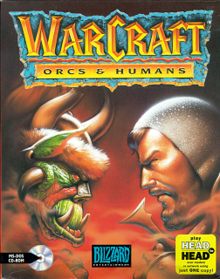 I think I played Command and Conquer for a very short time, but I don’t really remember that. It was kind of a high point of that style of RTS.
I think I played Command and Conquer for a very short time, but I don’t really remember that. It was kind of a high point of that style of RTS.
Age of Empires came along a few years later, and I played the heck out of that, as well as Age of Empires II. Both got rehabs and updates, and AoE II is totally playable. A buddy of mine is still addicted to the new version. AoE II is a classic which is still growing.
A few years ago, my son and I played a LOT of Star Wars: Empire at War, which came out in 2006. It swapped out resource gathering with a point-of-control system. It is a ton of fun.
For a Tolkien fan, Battle for Middle Earth I was fantastic. I didn’t play II, which I’ve heard was even better. It is possible to find an updated version of II that runs on modern Windows, but I haven’t managed to make that happen. Might really dial in on it sometime, and try. I was REALLY good for Tolkien fans.
There was a decent-enough D&D knock-off version, Dragonshard, in 2005. It mixed in a bit more RPG elements. I played it some, but Battle for Middle Earth was definitely superior.
Sid Meier is possibly the greatest game-creator of all time, with Civilization one of the most influential and popular games ever. His first game after leaving MicroProse was Sid Meier’s Gettysburg!, and it is a terrific Civil War game. You need to be totally immersed in it, but it’s a great Civil War game. Sid Meier’s Antietam! was similar.
And Railroad Tycoon was the standard railroad sim for a long time. 2018’s Railway Empire was a blast, and I have played that a fair amount.
I think it’s definitely cool that RTS is not limited to combat games (there are RTS World War games as well – I’ve only dabbled in those). Tropico, and Sim City, are two examples of RTS-type city-building games. I played a LOT of the first Tropico – that’s a fun game.
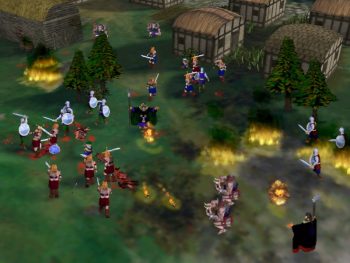 The only game that rivals TW:WH II for me, came out WAAAY back in 1997. Man, how can that be almost 30 years ago? I feel really old. But Bungie’s Myth: The Fallen Lords, was a terrific achievement. Story and game-play: just the EXPERIENCE.
The only game that rivals TW:WH II for me, came out WAAAY back in 1997. Man, how can that be almost 30 years ago? I feel really old. But Bungie’s Myth: The Fallen Lords, was a terrific achievement. Story and game-play: just the EXPERIENCE.
The land has fallen under almost total control of the forces of light (The Fallen Lords), led by Balor. The Light is led by powerful sorcerers, and you control an elite army unit called The Legion. You need to overcome The Fallen Lords. The developers cited Mel Gibson’s Braveheart, and Glen Cook’s fantastic The Black Company (you surely read my interview with him, here), as inspirations.
It is actually an RTT (Real Time Tactical) game. No resource gathering, no settlement growing. You don’t develop skill trees and build up unit strength. You start each scenario with your force fully ready to go.
It was essentially a unit-based combat game (NOT turn-based). But playing it still felt like a combat-based RTS, back then. Terrain and weather impacted things, which was neat at the time. You controlled units (usually in groups) to win battles. And no game I ever played had friendly fire as such a part of it. Those dwarven Molotov cocktails could take out your own forces.
Project Magma has converted the game to operate on current Windows systems. If I could focus in on it, I would probably go through the multiple steps and play this again. But TW: WH I, and II, are already installed, ready to play, and twenty years newer. Still, Myth Lords is one I’m tempted to try.
There was a sequel, and a prequel. But that original game is a masterpiece.

Bob Byrne’s ‘A (Black) Gat in the Hand’ made its Black Gate debut in 2018 and has returned every summer since.
His ‘The Public Life of Sherlock Holmes’ column ran every Monday morning at Black Gate from March, 2014 through March, 2017. And he irregularly posts on Rex Stout’s gargantuan detective in ‘Nero Wolfe’s Brownstone.’ He is a member of the Praed Street Irregulars, founded www.SolarPons.com (the only website dedicated to the ‘Sherlock Holmes of Praed Street’).
He organized Black Gate’s award-nominated ‘Discovering Robert E. Howard’ series, as well as the award-winning ‘Hither Came Conan’ series. Which is now part of THE Definitive guide to Conan. He also organized 2023’s ‘Talking Tolkien.’
He has contributed stories to The MX Book of New Sherlock Holmes Stories — Parts III, IV, V, VI, XXI, and XXXIII.
He has written introductions for Steeger Books, and appeared in several magazines, including Black Mask, Sherlock Holmes Mystery Magazine, The Strand Magazine, and Sherlock Magazine.
Book review: The Devil By Name by Keith Rosson (Fever House #2)

ABOUT THE AUTHOR: Keith Rosson is the author of the novels The Mercy of the Tide and Smoke City, and his short fiction has appeared in Cream City Review, PANK, December, The Nervous Breakdown, and more. He's been twice nominated for a Pushcart Prize and a finalist for the Birdwhistle Prize for Short Fiction. He’s also an illustrator and graphic designer, with clients that include Green Day, Against Me, the Goo Goo Dolls, and others. A fierce advocate of public libraries and non-ironic adulation of the cassette tape, he can be found at keithrosson.com.
Publisher: Random House (September 10, 2024) Length: 400 pages Formats: audiobook, ebook, paperback
The Devil by Name picks up five years after Fever House with all the chaos, gore, and gripping drama you’d expect—and then some. The world is still reeling from “The Message,” a weaponized sound that turned much of humanity into bloodthirsty monsters called the fevered. With Terradyne Industries running the show and humanity clinging to survival, the stakes have never been higher.
The book is a wild ride; it takes elements of horror, noir, and spy thriller vibes and turns them into a splatterfest that somehow still manages to be emotionally grounded. John Bonner, riddled with guilt and desperate for redemption, Katherine Moriarty, coping with devastating loss, and Naomi Laurent, a teenager with a mysterious, world-altering gift, are all struggling. Newcomer Dean Haggerty, a warm, resourceful scavenger, is an unexpected bright spot, bringing a glimmer of hope to a grim story.
Yes, the gore is intense, and the body horror will stick with you long after you’ve turned the last page (looking at you, “tortured fevered in the chair”). But here’s the thing - Rosson knows how to find a balance between the carnage and emotional depth, and his take on grief, redemption, and survival feels raw and real. The character arcs are top-notch, with even minor players leaving a mark. Katherine’s transformation, in particular, is spectacular.
The pacing is relentless, and while some plot conveniences (a possible cure-all across the ocean, for example) might raise an eyebrow, the story’s intensity and emotional pull make it easy to forgive. Rosson ties up loose ends from Fever House while introducing fresh twists, taking the story in surprising directions.
The final chapters are pure nightmare fuel, and the emotional punches hit hard. If you’re into stories that mix terror, heart, and a touch of hope, The Devil by Name delivers big time. It’s the kind of book that leaves you a little haunted but entirely satisfied.
Snake Eyes by Mark Henwick
Urban Fantasy
This is book 8 in the Amber Farrell / Bite Back series. To start at the beginning read the novella Raw Deal or Book 1, Sleight of Hand.

The first four of five books in the series were very much about discovery. Amber Farrell who is vampire, werewolf and witch was learning who she was. All the while battling the bad guys and each supernatural community where she was considered an abomination.
The more recent books have been about joining her separate parts, I guess “becoming” is a good word. And the last couple of books, Queen of Diamonds and Snake Eyes (essentially one book broken into two parts) seem to me to be her arriving at who she is.
This series is honestly one of the best. If you look at the books I read, you’ll notice 90% plus are written by women. Mark Henwick is one of a handful of male authors I read and reread. I’ve probably read most of the books in this series a dozen times. So if you love Urban Fantasy, do yourself a favour. Read Amber Farrell.
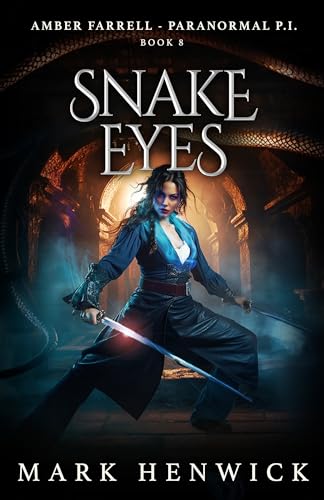
Audiobook Review: Tartufo by Kira Jane Buxton
I received a review copy from the publisher. This does not affect the contents of my review and all opinions are my own.
Mogsy’s Rating (Overall): 3.5 of 5 stars
Genre: Contemporary, Humor
Series: Stand Alone
Publisher: Hachette Audio (January 28, 2025)
Length: 11 hrs and 31 mins
AuthorInformation: Website | Twitter
Narrator: Caroline Hewitt
After thoroughly enjoying Kira Jane Buxton’s Hollow Kingdom series, I was looking forward to checking out Tartufo even though her newest novel falls outside my usual genres. I was mainly curious to see how her quirky sense of humor would transfer to a different kind of story, and while Tartufo does indeed take a more grounded approach, it still carries the author’s signature charm. Still, despite its playfulness and whimsy, the novel didn’t quite capture me in the same way as her previous work.
Set in the small, fictional Italian village of Lazzarini Boscarino, Tartufo tells the tale of a group of residents who will do anything to keep their dying town on the map. With most of the younger generation having departed for greener pastures in the big cities, the remaining aging population is left to hold what’s left of their beloved home together. But the crisis deepens as it is revealed that the previous mayor had died without leaving any available funds for rebuilding and revitalizing. Now his daughter Delizia returns home to handle his affairs only to find herself elected as the new mayor—after nearly losing the race to a donkey—with the unenviable task of turning things around, all the while struggling with her own personal ambitions and disappointments.
Then one day, a local truffle hunter named Giovanni heads out into the forest with his dogs, doing what he loves most, when he suddenly stumbles upon an enormous truffle—quite possibly the largest specimen the world has ever seen. Realizing its potential, Giovanni brings it to the rest of the village, hoping it’s exactly what they need to bring attention back to Lazzarini Boscarino. However, what begins as a stroke of extraordinary luck soon spirals out of control as the attention the town receives also includes that of the negative variety, motivated by enmity and greed. Instead of bringing the community together, the discovery of the truffle threatens do the exactly opposite, forcing everyone to question what future they want for their town.
If you’re looking for some casual reading or a book to sit back and relax with, Tartufo is the perfect choice—relatively low stakes, brimming with charm and wit. For me, it felt a lot like watching a lighthearted musical. The human characters are oddballs, with some portrayals leaning into satire and caricature, filling the cast with over-the-top personalities that wouldn’t feel too out of place in a stage comedy. The novel is also a treat for the senses. Descriptive writing is dialed up to the max, painting a gorgeously evocative picture of the setting. The Italian countryside is described so vividly you can practically smell the delicious scent of food and wine in the restaurants and feel the warmth under the Mediterranean sun. The village of Lazzarini Boscarino is itself as much a character as its eccentric inhabitants, written with the same amount of care and detail.
Buxton has also chosen to tell this story in an omniscient point of view, a brilliant decision which allowed her to do something that has become part of her signature style—writing from the perspective of animals. Inserted between character POVs are scenes told through the eyes of creatures like Giovanni’s truffle-hunting dog, a cat named Al Pacino (despite it being female), and even a passing honeybee. Not only is it reminiscent of the Hollow Kingdom series, which was told through the eyes of a very clever crow, it’s a quirk of the writing which adds an unexpected layer of depth to the story.
Despite the whimsical nature of Tartufo, there’s a distinct lack of supernatural elements, though that alone didn’t take away from my enjoyment. More challenging was the way the narrative juggles so many different POVs, leaving some important characters underdeveloped. It’s also a little too silly in places, making it harder for me to fully immerse myself in the conflict, and there were moments where I wished for more emotional depth.
Nevertheless, Tartufo remains a delightful read, showcasing Kira Jane Buxton’s storytelling abilities. While the playful tone occasionally goes overboard with it and becomes tiresome, on the whole the book is entertaining and endearing. At its heart, it’s a story about togetherness and the dreams of a community, and though I didn’t connect with it as deeply as the author’s Hollow Kingdom, I still had a good time with its humor and themes.
![]()
![]()
The Fiction of Edgar Rice Burroughs, Part II: Tarzan and The Land That Time Forgot
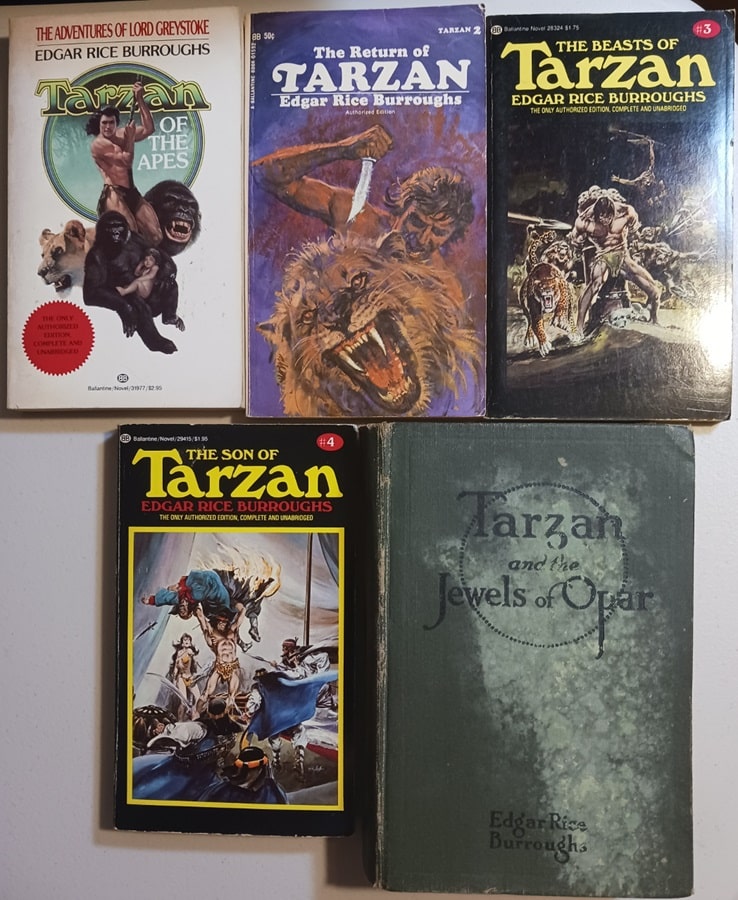 Tarzan novels #1 – #5 : Tarzan of the Apes, The Return of Tarzan, The Beasts of Tarzan, and The Son of Tarzan (Ballantine Books, December 1983, April 1969, April 1975, April 1975), and Tarzan and the Jewels of Opar (A.L. Burt, 1919). Covers by Charles Ren, Bob Abbett, Neal Adams, and Neal Adams.
Tarzan novels #1 – #5 : Tarzan of the Apes, The Return of Tarzan, The Beasts of Tarzan, and The Son of Tarzan (Ballantine Books, December 1983, April 1969, April 1975, April 1975), and Tarzan and the Jewels of Opar (A.L. Burt, 1919). Covers by Charles Ren, Bob Abbett, Neal Adams, and Neal Adams.
Any discussion of Sword & Planet fiction needs to start with Edgar Rice Burroughs and his book A Princess of Mars. I discussed that series extensively — and also his other S&P series, the Carson of Venus books, and his Moon Maid trilogy, which is partially S&P — in Part I of this series.
But, of course, ERB wrote many other books that have no connection to S&P fiction. They are still very good stories, though, entertaining and worth discussing. I thought I’d cover some in my next series of posts.
Most readers I know discovered ERB through the character of Tarzan. The first ERB I read was A Princess of Mars, but the second one was Tarzan Lord of the Jungle. The book was an old hardback, with no dust cover. The cover was generally brown with the title embossed on it. I found it among my sister’s books. She was the only other big reader in my family. I don’t know how she came upon it. I still remember some fifty+ years later the opening scene, with Tarzan dozing on the back of Tantor the elephant. And before long Tarzan finds a lost civilization of crusaders in deepest Africa. And there was swashbuckling.
[Click the images for Tarzan-sized versions.]
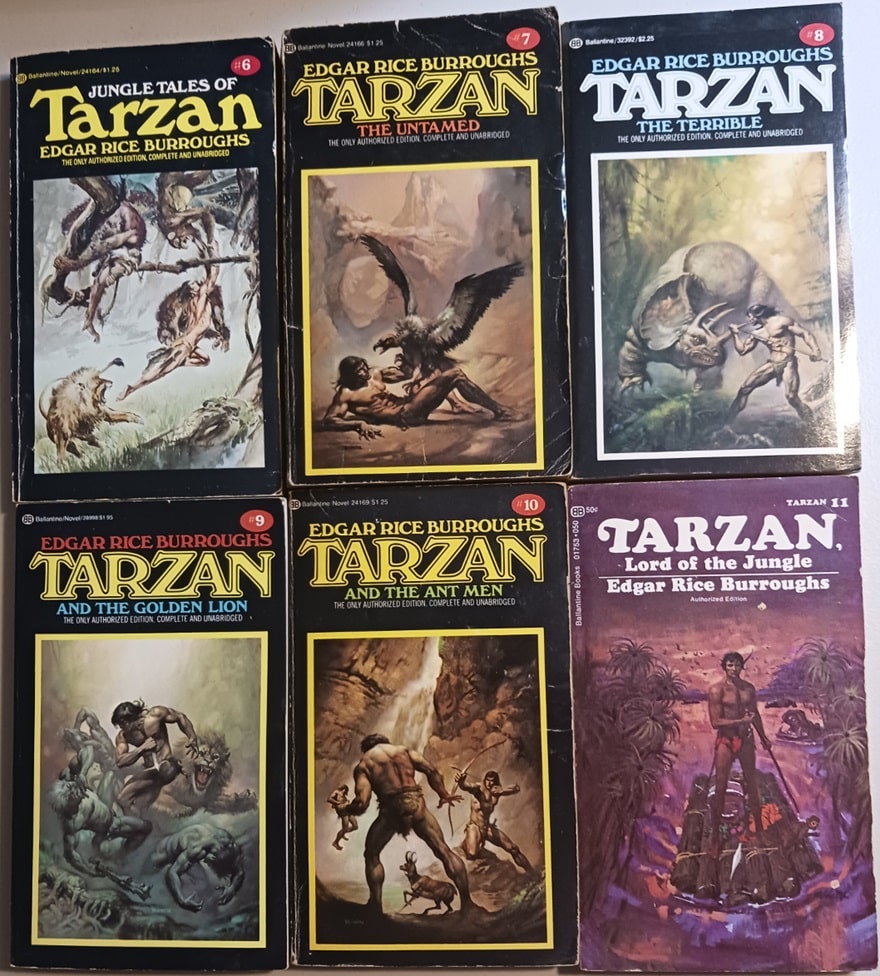 Tarzan #6 – #11: Jungle Tales of Tarzan, Tarzan the Untamed, Tarzan the Terrible, Tarzan and the Golden Lion, Tarzan and the Ant Men, and Tarzan, Lord of the Jungle (Ballantine Books, 1975-1976, and 1969). Covers by Neal Adams, Boris Vallejo, and Bob Abbett.
Tarzan #6 – #11: Jungle Tales of Tarzan, Tarzan the Untamed, Tarzan the Terrible, Tarzan and the Golden Lion, Tarzan and the Ant Men, and Tarzan, Lord of the Jungle (Ballantine Books, 1975-1976, and 1969). Covers by Neal Adams, Boris Vallejo, and Bob Abbett.
I’ve always liked best the Tarzan tales where he discovers a lost race. There were a lot of them in Africa, apparently. That copy of the book fell apart and I eventually replaced it with a paperback. When I started buying the Tarzan books I couldn’t afford to get them all at once, and I also picked up ones here and there from used bookstores or book sales. Most of the ones I found were from the Ballantine editions, many with great Boris Vallejo covers, which became my “mind’s eye” image of Tarzan.
Above I show the first 11 books in my collection. All but Jewels of Opar are from Ballantine, published between 1963 and 1973 it looks like. Covers are varied.
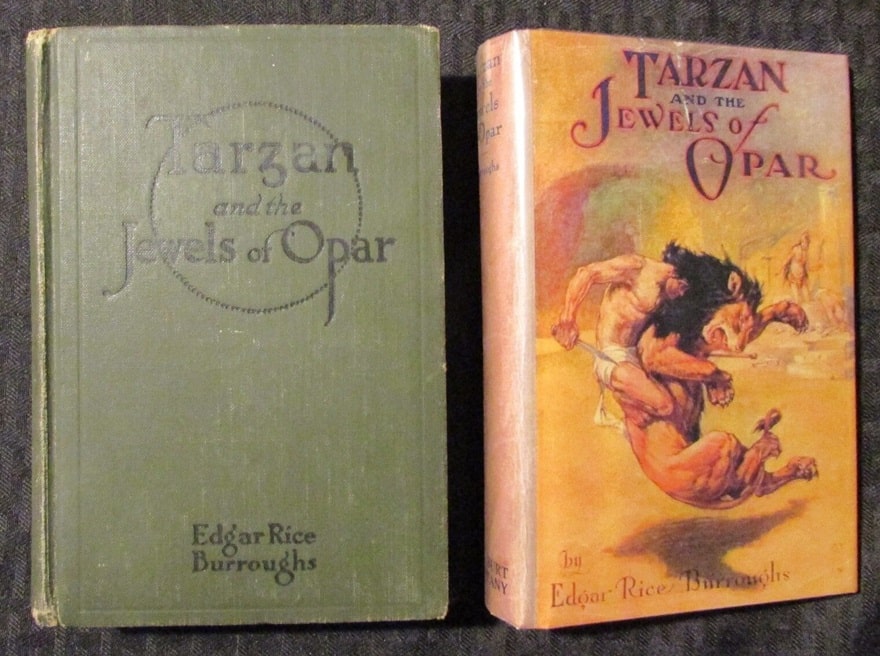 Tarzan and the Jewels of Opar (A.L. Burt Company, 1919). Cover by J. Allen St. John
Tarzan and the Jewels of Opar (A.L. Burt Company, 1919). Cover by J. Allen St. John
Here’s the list of cover artists.
Tarzan of the Apes; Charles Ren
The Return of Tarzan; Robert Abbett
Beasts of, Son of, Jungle Tales of; Neal Adams
Untamed, Terrible, Golden Lion, Ant Men; Boris Vallejo
Lord of the Jungle; Robert Abbett
My copy of Tarzan and the Jewels of Opar was published in 1919 by A. L. Burt Company. It lacks a dust cover, but above is a picture I took off the internet of what it apparently looked like. The beautiful cover is by J. Allen St. John (1872 – 1957), who was an incredible artist.
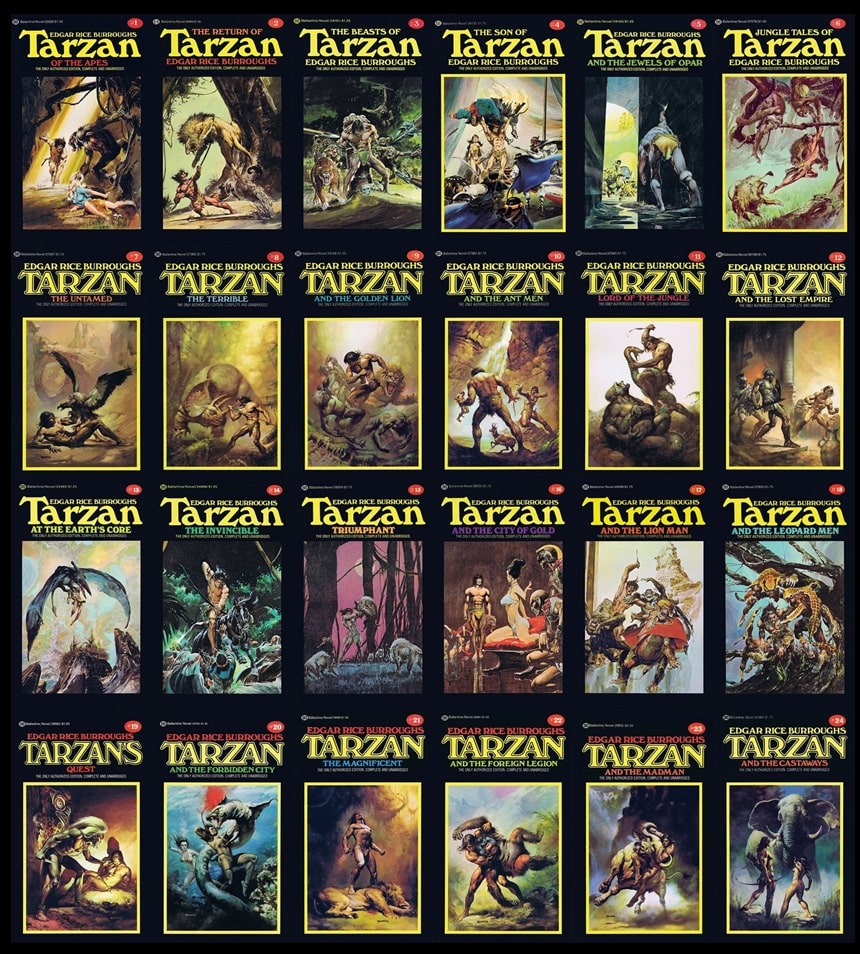 The 24 Tarzan novels and collections published in sequence in paperback by Ballantine Books, 1975 – 1977. Covers by Neal Adams and Boris Vallejo
The 24 Tarzan novels and collections published in sequence in paperback by Ballantine Books, 1975 – 1977. Covers by Neal Adams and Boris Vallejo
Burroughs wrote 26 books about Tarzan, but typically only 24 are counted as part of the main sequence. The two odd numbers out are The Tarzan Twins, which I have, and Tarzan and the Tarzan Twins with Jad-Bal-Ja The Golden Lion, which I’ve never seen. These are novellas written for young readers. They were published separately but were collected together at one point, although I can’t find a copy of that publication.
The copy of The Tarzan Twins that I have is from Wildside Press with a cover by Douglas Grant. It’s the only ERB book I don’t like and doesn’t even seem like ERB to me. ERB’s work was already accessible to young readers. Most people I know read them pretty young, so for him to “try” to write down to kids just didn’t work — at least to me.
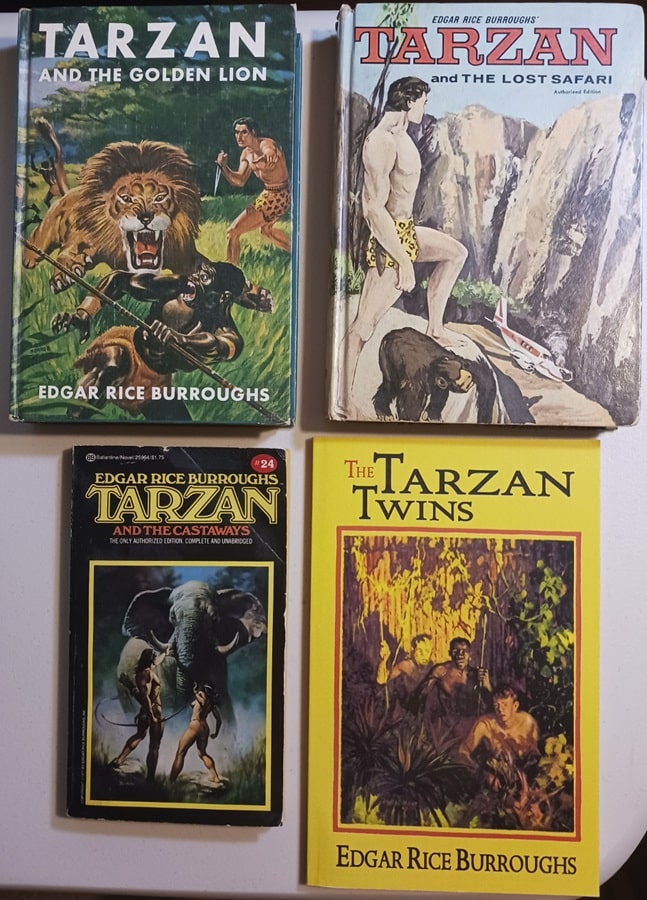 Tarzan and the Golden Lion (Grosset & Dunlap, 1949), Tarzan and the Lost Safari (Whitman Publishing, January 1, 1966, author unknown), Tarzan and the Castaways (Ballantine, September 1977), and The Tarzan Twins (Wildside Press, September 14, 2005). Covers by C. Edmund Monroe, Jr., Tony Sgroi, Boris Vallejo, and Douglas Grant.
Tarzan and the Golden Lion (Grosset & Dunlap, 1949), Tarzan and the Lost Safari (Whitman Publishing, January 1, 1966, author unknown), Tarzan and the Castaways (Ballantine, September 1977), and The Tarzan Twins (Wildside Press, September 14, 2005). Covers by C. Edmund Monroe, Jr., Tony Sgroi, Boris Vallejo, and Douglas Grant.
Overall, the Tarzan series is certainly not my favorite among ERB’s work anyway. They’re actually fairly low on my list of ERB favorites, although — don’t get me wrong — still very good. A ranking of my favorite series would be John Carter, Moon Maid, Carson of Venus, Land that Time Forgot, and Pellucidar, with Tarzan coming after that. Some of my favorite standalones would be The Outlaw of Torn, The Mad King, and I Am A Barbarian.
The Tarzan tales were almost certainly influenced by Rudyard Kipling’s jungle book tales of Mowgli, the wild boy of the forest — which in turn was influenced by some true reports from the mid-1800s of children in India being raised by wolves. ERB may have been directly aware of those same tales as well, and likely knew of the “Wild Boy of Aveyron,” who, around 1800, was found living in the wilds in France. The French feral child was named Victor by one of his “rescuers.” Unlike Tarzan, he never really learned to speak, although he apparently understood some language.
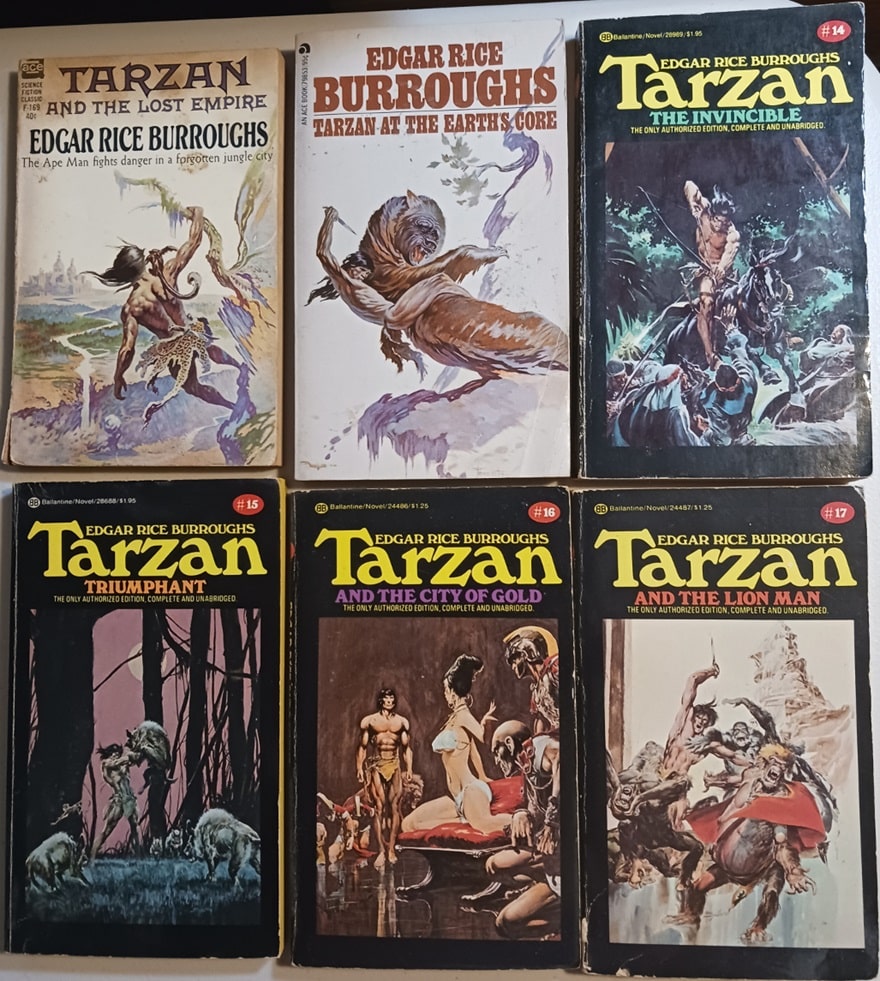 Tarzan #12 – #17: Tarzan and the Lost Empire and Tarzan at the Earth’s Core (Ace Books, November 1962 and March 1963), and Tarzan the Invincible, Tarzan Triumphant, Tarzan and the City of Gold, and Tarzan and the Lion Man (Ballantine Books, November 1975). Covers by Frank Frazetta and Neal Adams.
Tarzan #12 – #17: Tarzan and the Lost Empire and Tarzan at the Earth’s Core (Ace Books, November 1962 and March 1963), and Tarzan the Invincible, Tarzan Triumphant, Tarzan and the City of Gold, and Tarzan and the Lion Man (Ballantine Books, November 1975). Covers by Frank Frazetta and Neal Adams.
Above and below are the remaining Tarzan book pictures from my collection. The Ace copy of Lost Empire with the Frazetta cover that looks like it was inspired by Roy Krenkel Jr’s work is a real prize. I also have an Ace copy of Tarzan at the Earth’s Core, which also ties into ERB’s Pellucidar series, with a wonderful Frazetta cover.
The rest of my regular series are all Ballantine, with the following cover artists.
Invincible, Triumphant, City of Gold, Lion Man, Leopard Men; Neal Adams
Quest, Forbidden City, Magnificent, Foreign Legion, Madman, Castaways; Boris Vallejo
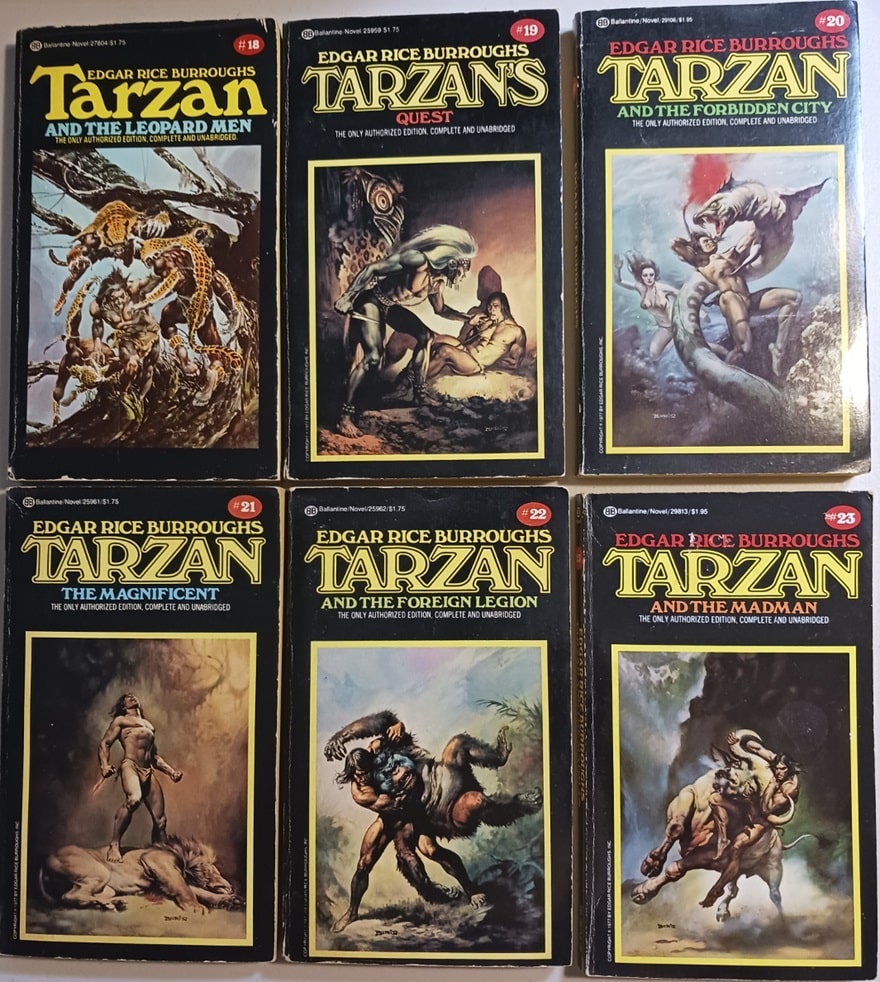 Tarzan #18 – #23: Tarzan and the Leopard Men ((Ballantine Books, November 1975, cover by Neal Adams), and Tarzan’s Quest, Tarzan and the Forbidden City, Tarzan the Magnificent, Tarzan and the Foreign Legion, and Tarzan and the Madman (Ballantine Books, September 1977, covers by Boris Vallejo).
Tarzan #18 – #23: Tarzan and the Leopard Men ((Ballantine Books, November 1975, cover by Neal Adams), and Tarzan’s Quest, Tarzan and the Forbidden City, Tarzan the Magnificent, Tarzan and the Foreign Legion, and Tarzan and the Madman (Ballantine Books, September 1977, covers by Boris Vallejo).
My second copy of Tarzan and the Golden Lion is from Grosset & Dunlap and clearly looks targeted toward younger readers with that cover (see above) — which is pretty cringeworthy for moderns. Not sure when it was published or who the cover artist might be.
Tarzan and the Lost Safari is adapted from the Tarzan movie of that same name. It was published by Whitman and doesn’t list an author, although I’ve seen Frank Castle’s name attached to it. I’ve seen this book for sale as by “Edgar Rice Burroughs.” It’s not. It’s closer to the movie Tarzan than to ERB’s creation. I didn’t find it very entertaining.
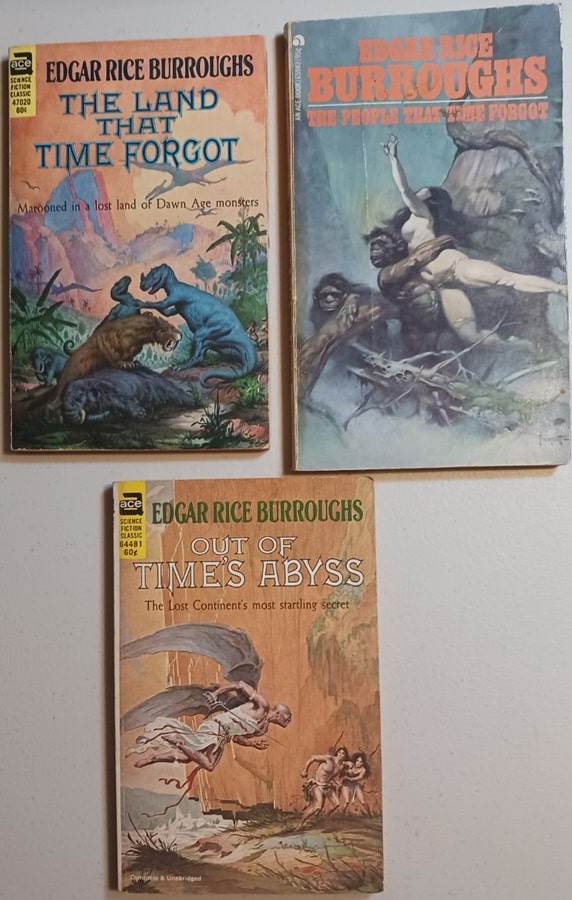 Three novels of The Lost Continent by Edgar Rice Burroughs: The Land That Time Forgot, The People That Time Forgot, and Out of Time’s Abyss (Ace Books, 1963, January 1973, and October 1963). Covers by Roy Krenkel, Jr, Frank Frazetta, and Roy Krenkel, Jr.
Three novels of The Lost Continent by Edgar Rice Burroughs: The Land That Time Forgot, The People That Time Forgot, and Out of Time’s Abyss (Ace Books, 1963, January 1973, and October 1963). Covers by Roy Krenkel, Jr, Frank Frazetta, and Roy Krenkel, Jr.
I personally don’t believe that ERB has been well served by the film and TV industries. I may be in the minority here but I find the early Tarzan movies to be virtually unwatchable. They seem to have very little to do with ERB’s characterization of Tarzan. The first Tarzan movie I actually liked was Greystoke: The Legend of Tarzan, starring Christopher Lambert. It still wasn’t the Tarzan I knew from the books but they made an effort to capture some of the character’s origins. I also liked most of the 2016 Legend of Tarzan, with Alexander Skarsgard, who I believe captured the essence of the character better than any previous Tarzan.
I generally liked the John Carter of Mars film, although they made changes that weren’t needed, but my favorite ERB adaptations are definitely a couple of B-movies starring Doug McClure. I’m talking about The People that Time Forgot, and The Land that Time Forgot. I’ve given these — especially the first one — frequent rewatches. Although the special effects are pretty awful by modern standards, the spirit of ERB’s stories shine through, the mystery and the exotic.
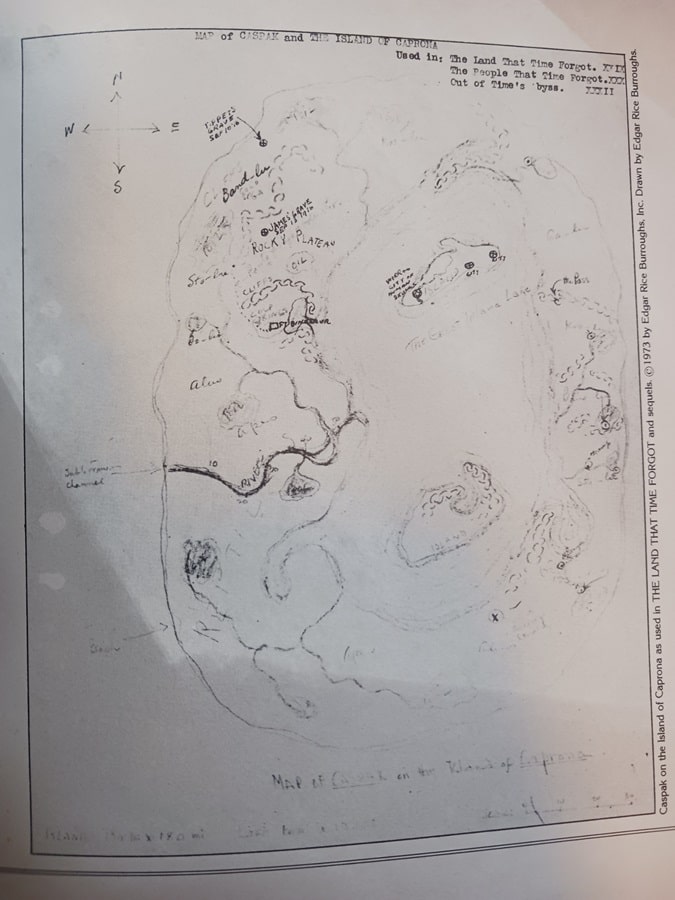 A map of Caprona, the Land that Time Forgot, from An Atlas of Fantasy by J. B. Post (Ballantine Books, 1979)
A map of Caprona, the Land that Time Forgot, from An Atlas of Fantasy by J. B. Post (Ballantine Books, 1979)
Of course, I loved the trilogy that spawned these movies — The Land that Time Forgot, The People that Time Forgot, and Out of Time’s Abyss. I thought Doug McClure did a good job with the character of Bowen Tyler, who becomes the first American to set foot on Caprona, a lost world near Antarctica where time seems to have stopped and dinosaurs still survive. There’s also a deep mystery about how things “evolve” on Caprona, though I won’t give it away.
Above are the three copies I have, all from Ace. Frazetta did the cover for The People while the other two are by Roy Krenkel, Jr. I’m also including a map of Caprona featured in An Atlas of Fantasy.
More on Burroughs next time.
Charles Gramlich administers The Swords & Planet League group on Facebook, where this post first appeared. His last article for Black Gate was The Fiction of Edgar Rice Burroughs, Part I: Sword and Planet.
The Intersection of Hobbies: Dungeons & Dragons, John Eric Holmes, and Tarzan
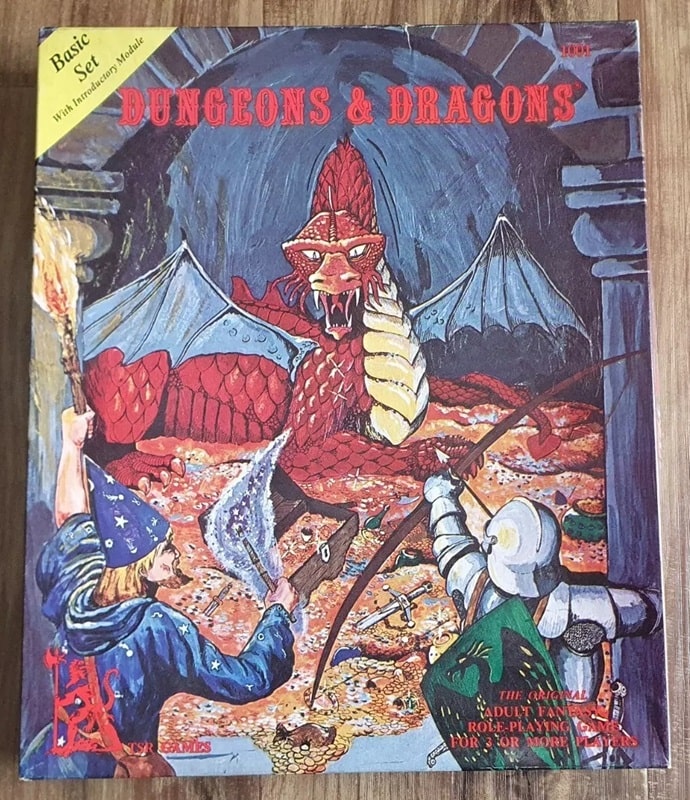 Dungeons & Dragons Basic Set by John Eric Holmes, based on Dungeons & Dragons by Gary Gygax and Dave Arneson (TSR Games, 1977). Cover by David Sutherland
Dungeons & Dragons Basic Set by John Eric Holmes, based on Dungeons & Dragons by Gary Gygax and Dave Arneson (TSR Games, 1977). Cover by David Sutherland
There are many intersections between my favorite hobby (which is also my line of work) and my favorite fiction. One of these intersections is represented by Dr. John Eric Holmes and the fiction of Edgar Rice Burroughs.
When I was a youth, the first Dungeons & Dragons set that I owned was edited by Dr. Holmes. That “basic” set served as the foundation to my understanding of all things D&D. Now, this was in 1981, when I was in the fifth grade. This was also the year in which I was devouring Tarzan novels, written by Edgar Rice Burroughs. My keen interest in Tarzan was fueled by the CBS Saturday morning cartoon, Tarzan, Lord of the Jungle.
[Click the images for Tarzan-sized versions.]
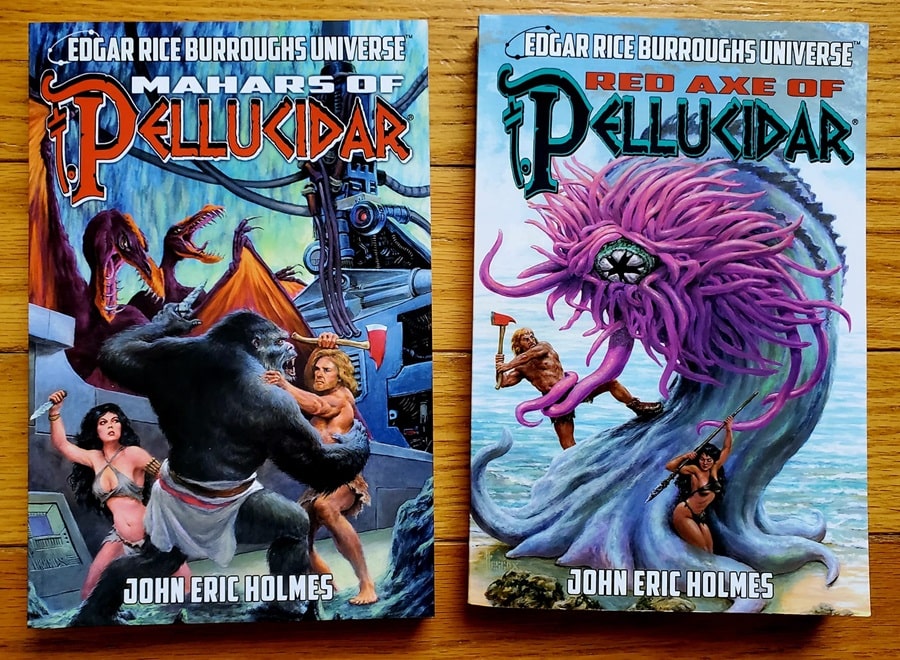 Pellucidar novels by John Eric Holmes: Mahars of Pellucidar and Red Axe of Pellucidar (Edgar Rice Burroughs, Inc., September 6, 2022). Covers by Richard Hescox
Pellucidar novels by John Eric Holmes: Mahars of Pellucidar and Red Axe of Pellucidar (Edgar Rice Burroughs, Inc., September 6, 2022). Covers by Richard Hescox
As I got older, I delved into other works by Burroughs, such as the Barsoom, Amtor, and Pellucidar stories. It wasn’t until recent years that I learned that Dr. Holmes had written two Pellucidar novels himself, the first of which was published in his lifetime, the other which was not: Mahars of Pellucidar and Red Axe of Pellucidar.
I am looking forward to reading these two books soon, probably spaced between my Zelazny readings. It’s nice to see that each of these books includes a foreword by Chris Holmes, one of Dr. Holmes’ children, whom I have had the pleasure to speak with several times at North Texas RPG Con.
 The complete Tarzan novels and collections by Edgar Rice Burroughs, published in paperback by Ballantine Books, 1975 – 1977. Covers by Neal Adams and Boris Vallejo
The complete Tarzan novels and collections by Edgar Rice Burroughs, published in paperback by Ballantine Books, 1975 – 1977. Covers by Neal Adams and Boris Vallejo
When I was young, my first exposure to Tarzan, created by Edgar Rice Burroughs, was the 1966 Tarzan TV series, starring Ron Ely. This was followed by the 1976–1980 animated series, Tarzan, Lord of the Jungle, which really captured my imagination.
I can still hear my brother Bob doing his “Bolmangani” voice from that cartoon. (The Bolmangani were evil gorilla-men that Tarzan often faced.) The show was excellent, and I particularly enjoyed the opening narration:
The jungle: Here I was born; and here my parents died when I was but an infant. I would have soon perished, too, had I not been found by a kindly she-ape named Kala, who adopted me as her own and taught me the ways of the wild. I learned quickly, and grew stronger each day, and now I share the friendship and trust of all jungle animals. The jungle is filled with beauty, and danger; and lost cities filled with good, and evil. This is my domain, and I protect those who come here; for I am Tarzan, Lord of the Jungle!
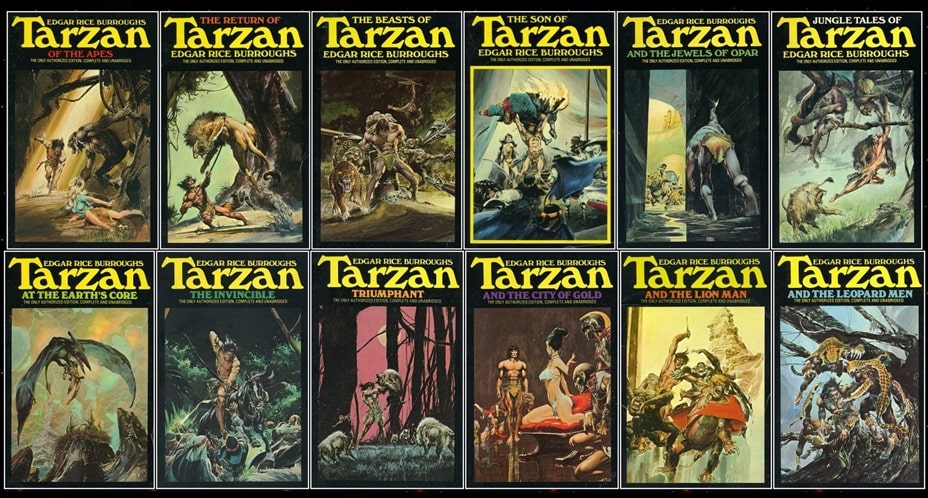 The twelve Neal Adams covers for the Ballantine Tarzan.
The twelve Neal Adams covers for the Ballantine Tarzan.
It was some time around 1981 that I began reading the actual ERB Tarzan books. I was completely enthralled within a few pages. The writing style of ERB was something like I’d never encountered before.
Pictured below is the cover art for the first Tarzan novel that I read, Tarzan of the Apes, published in 1977 by Ballantine Books. It was painted by Neal Adams, whose art was superb. In fact, I am of the opinion that Neal did the finest rendition of Batman to this day.
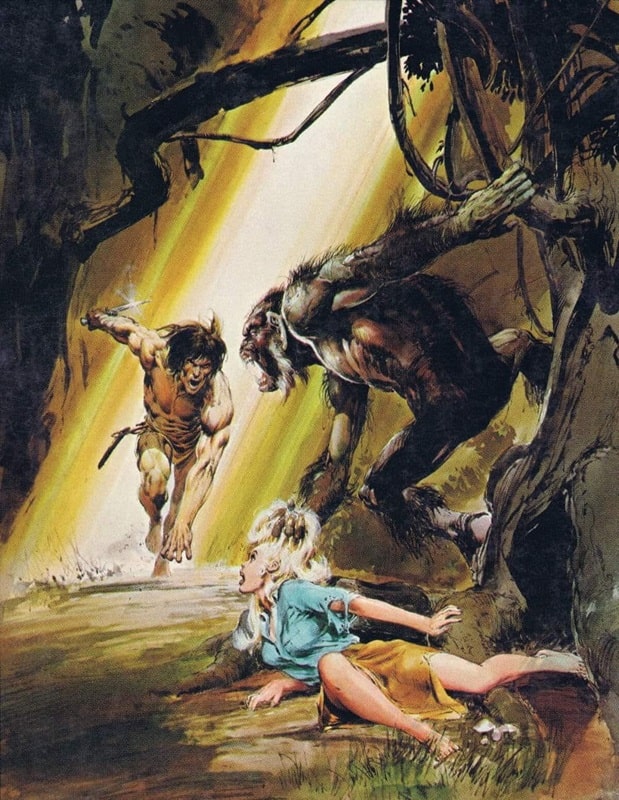 Cover art for Tarzan of the Apes by Neal Adams
Cover art for Tarzan of the Apes by Neal Adams
Anyway, the Neal Adams art is what drew me to purchase the first Tarzan book at my local Walden Books. It led me to a lifelong fascination with the incredibly imaginative works of Edgar Rice Burroughs.
In fact, I can open any ERB book to any random page, start reading, and find myself sucked into a world of wonder.
Jeffrey P. Talanian’s last article for Black Gate was Savage Sword of Conan is Back. He is the creator and publisher of the Hyperborea sword-and-sorcery and weird science-fantasy RPG from North Wind Adventures. He was the co-author, with E. Gary Gygax, of the Castle Zagyg releases, including several Yggsburgh city supplements, Castle Zagyg: The East Mark Gazetteer, and Castle Zagyg: The Upper Works. Read Gabe Gybing’s interview with Jeffrey here, and follow his latest projects on Facebook and at www.hyperborea.tv.
Is Sophie’s Choice a True Story? – Revisiting “Sophie’s Choice”
Is Sophie's Choice a true story? Styron based his novel on his memory of a real-life woman named Sophie, a survivor of Auschwitz he met in Brooklyn.
The post Is Sophie’s Choice a True Story? – Revisiting “Sophie’s Choice” appeared first on LitStack.




Recent comments